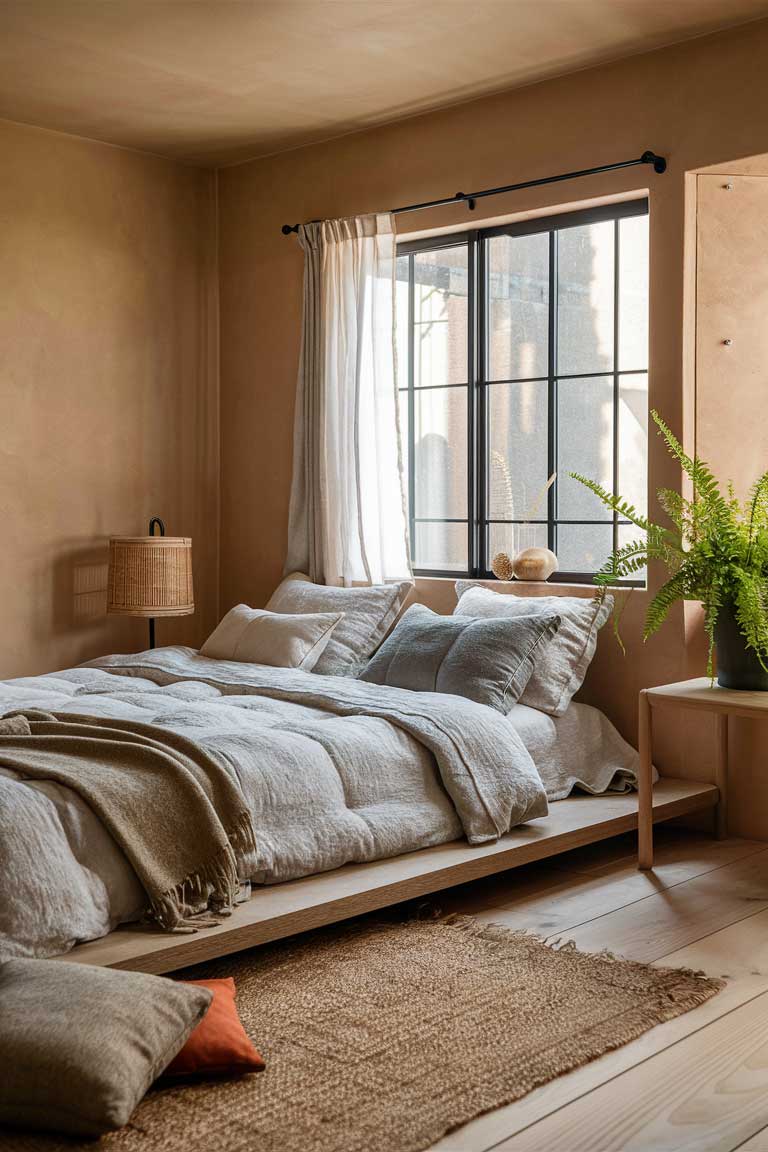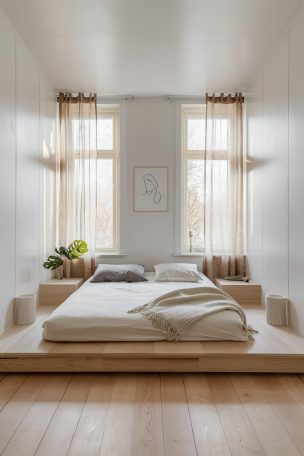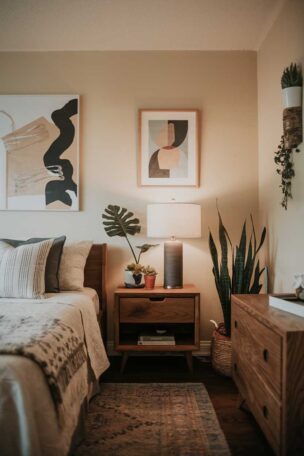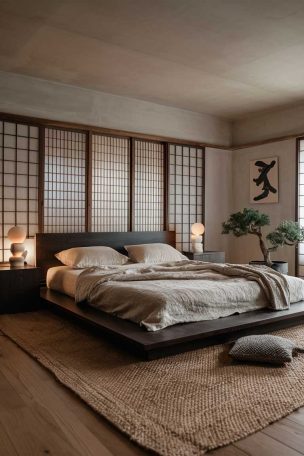In the world of interior design, the fusion of Japanese and Scandinavian aesthetics has given birth to a calming and functional style: Japandi.
This hybrid design philosophy is particularly well-suited for small spaces where every square inch counts.
If you want to transform your compact sleeping quarters, Japandi style bedroom ideas might be the perfect solution.
Japandi design marries the warmth of Scandinavian hygge with the minimalist zen of Japanese interiors.
It’s all about creating a space that’s cozy and clutter-free—a sanctuary where you can truly relax and recharge.
In this article, we’ll explore how to apply these principles to small bedroom designs, turning even the tiniest of spaces into serene retreats.
Let’s dive into the world of Japandi small bedroom interior design and discover how to make the most of your space while embracing this harmonious style.
The Essence of Japandi Style in Small Bedrooms
Minimalist Furniture Choices
When it comes to Japandi small bedroom design, less is definitely more.
The key is to choose furniture that’s both functional and aesthetically pleasing without overwhelming the space.
Low-profile platform beds are a staple in this style, creating a grounded feel while making the room appear larger.
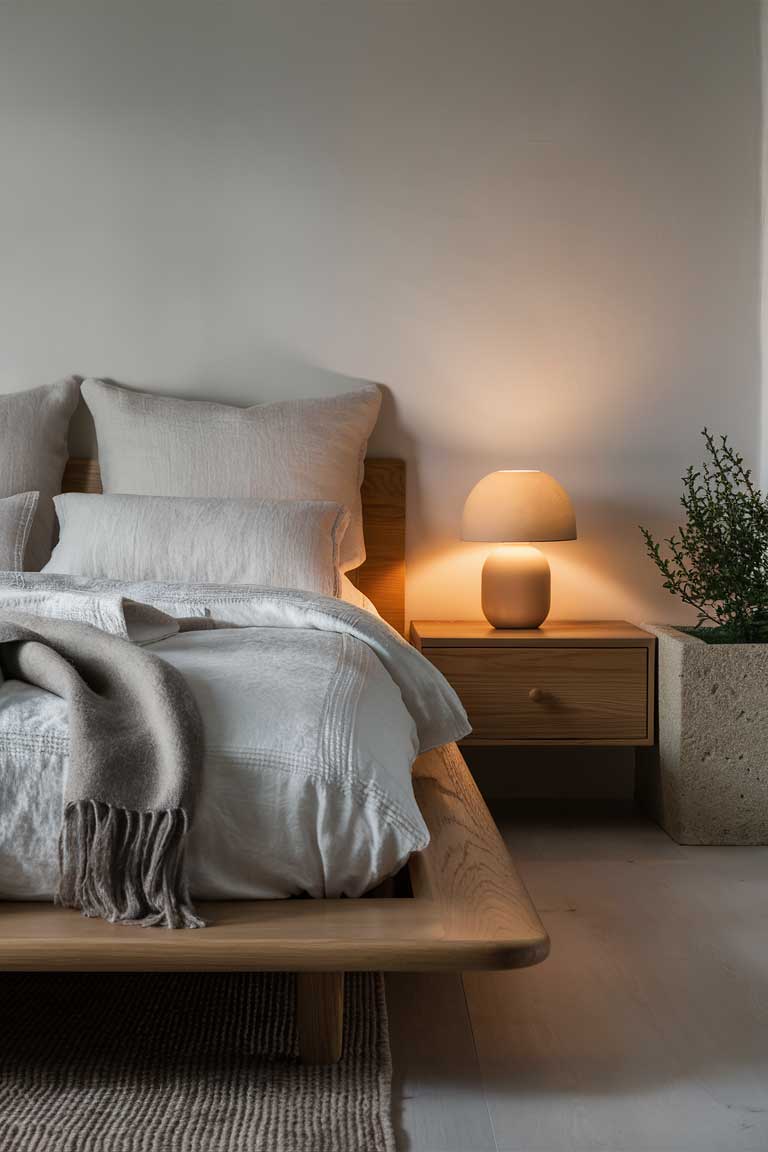
Floating shelves and nightstands are another clever way to maximize floor space while providing necessary storage.
These pieces seem to disappear into the wall, maintaining the room’s open feel while still offering functionality.
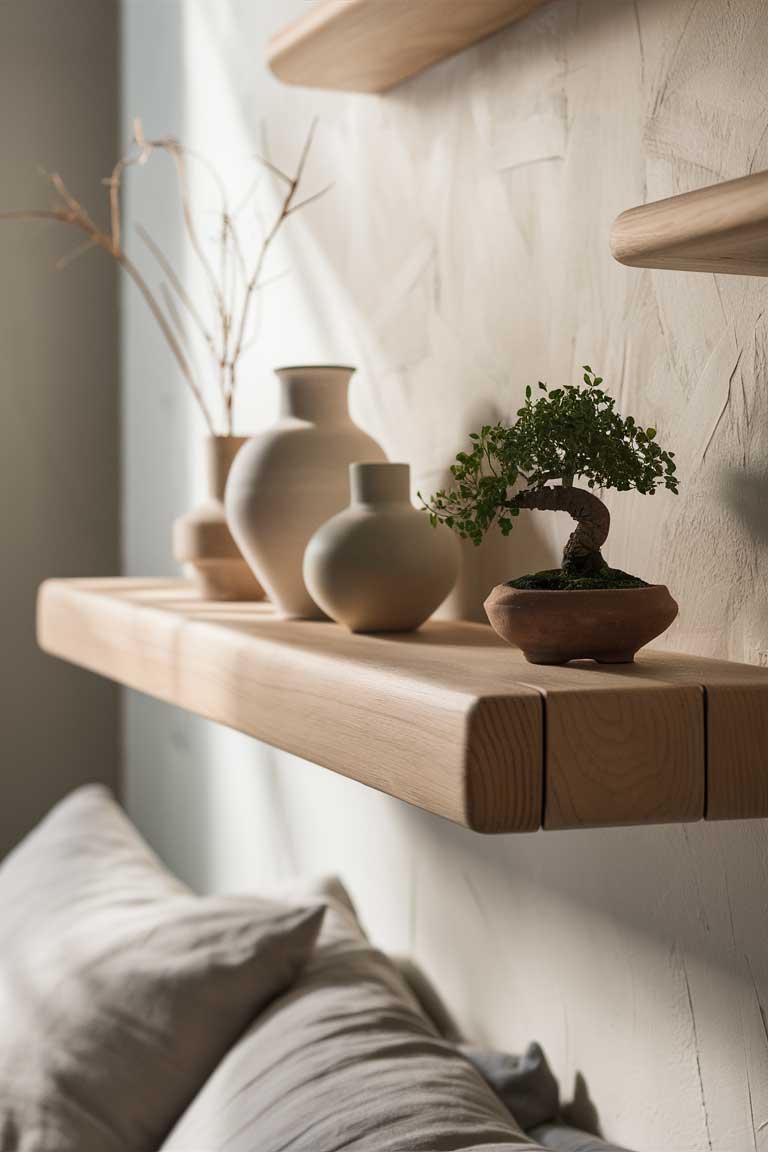
Built-in storage solutions are also a hallmark of Japanese bedroom design.
Think hidden compartments in bed frames or custom-built wardrobes that blend seamlessly with the walls.
These elements help maintain the clean lines and uncluttered aesthetic crucial to the Japandi style.
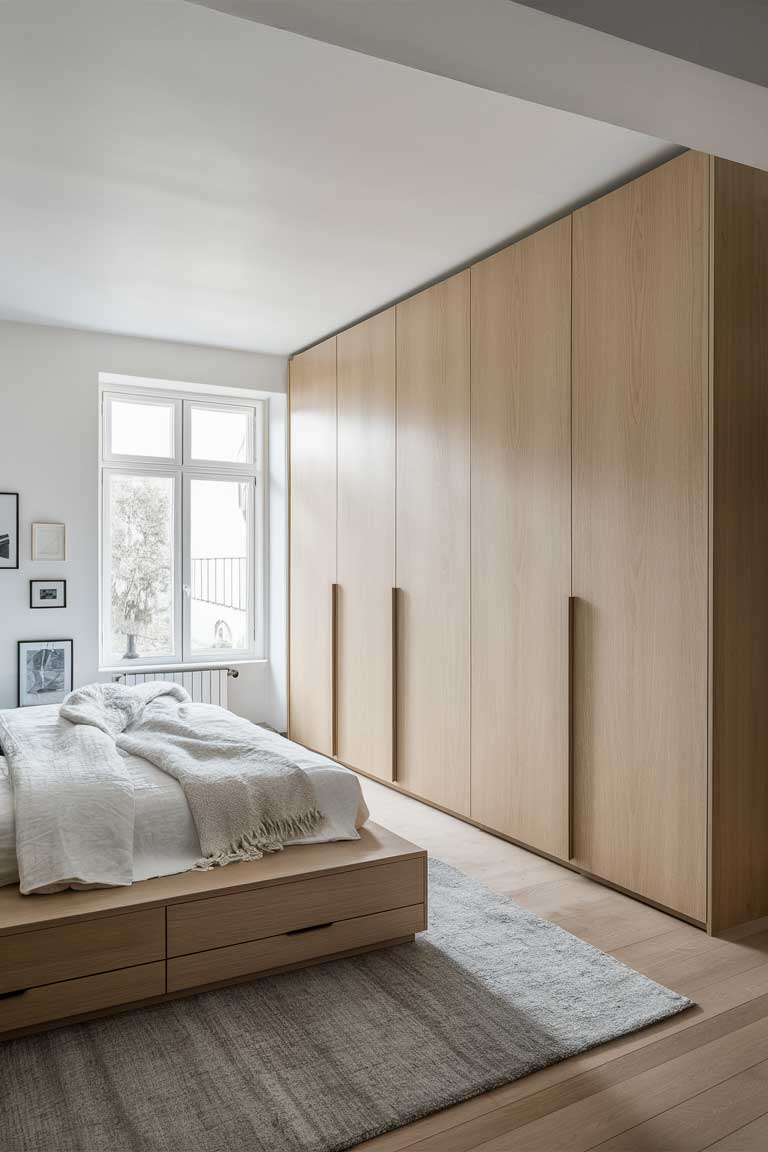
Natural Materials and Textures
One of the defining features of Japandi design is its focus on natural materials and textures.
This approach adds warmth to the space and creates a connection with nature, which can be especially soothing in a bedroom environment.
Light wood accents are a staple in minimal Japandi bedroom designs.
Opt for pale oak, ash, or birch to create that characteristic
Scandinavian-inspired warmth, whether it’s your bed frame, nightstands, or decorative elements.
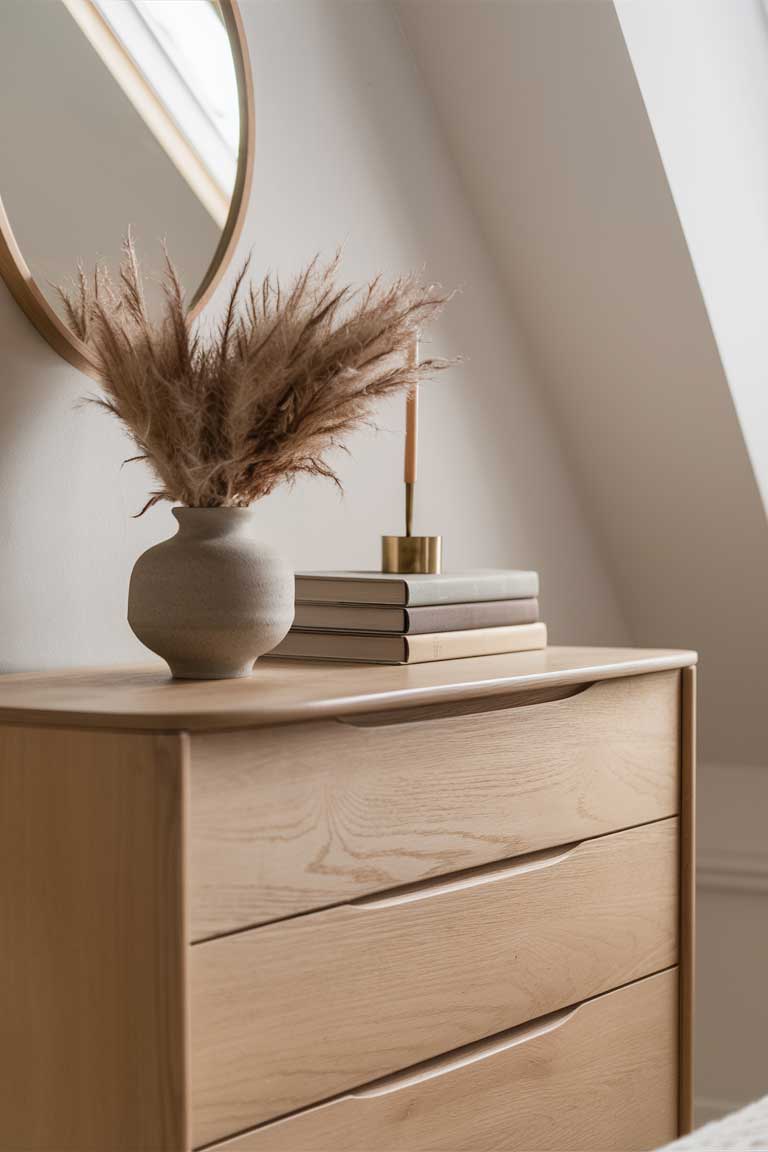
Tatami-inspired elements can add a distinctly Japanese touch to your space.
While traditional tatami mats might be too much for a small room, you can incorporate their essence with a small area rug made from natural fibers.
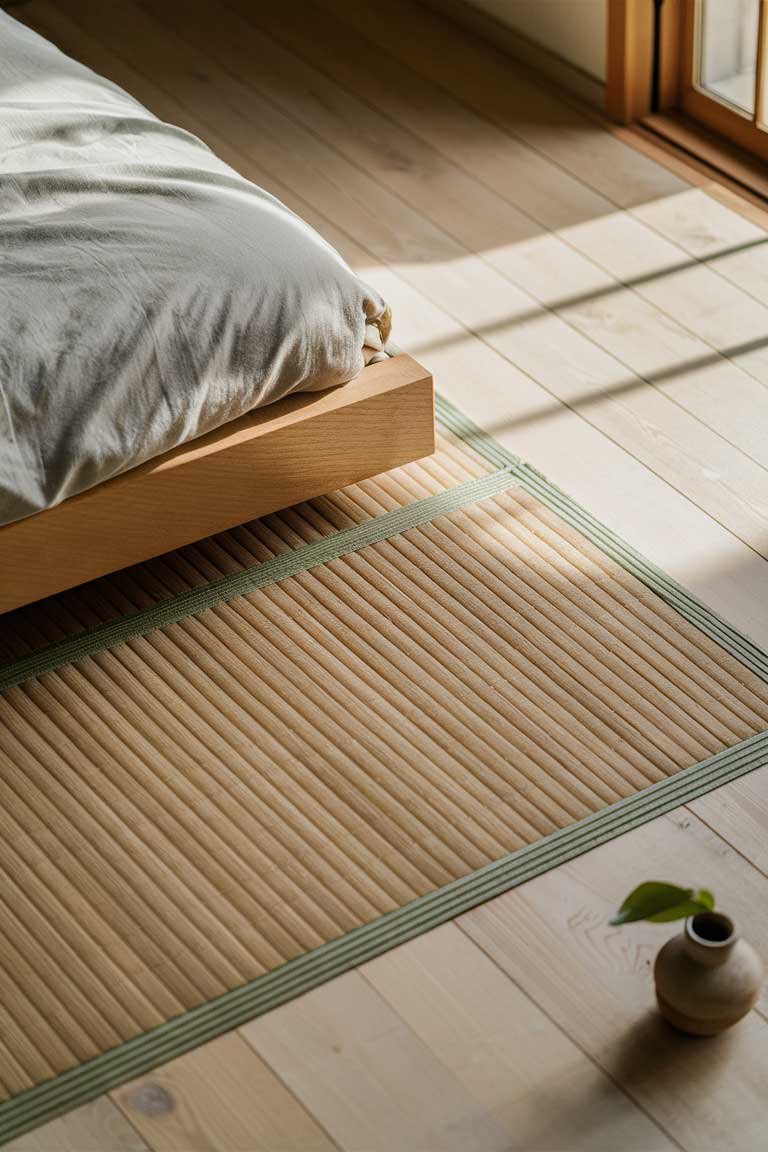
Organic textiles are crucial in softening the minimalist lines of Japandi interiors.
Think linen bedding, cotton throws, and jute or wool rugs.
These materials add texture and comfort without introducing busy patterns that could clutter the visual space.

Neutral Color Palettes
The color palette in a small Japandi bedroom is crucial for creating a sense of space and tranquility.
Soft beiges and grays form the foundation, creating a calming backdrop that makes the room feel more spacious.
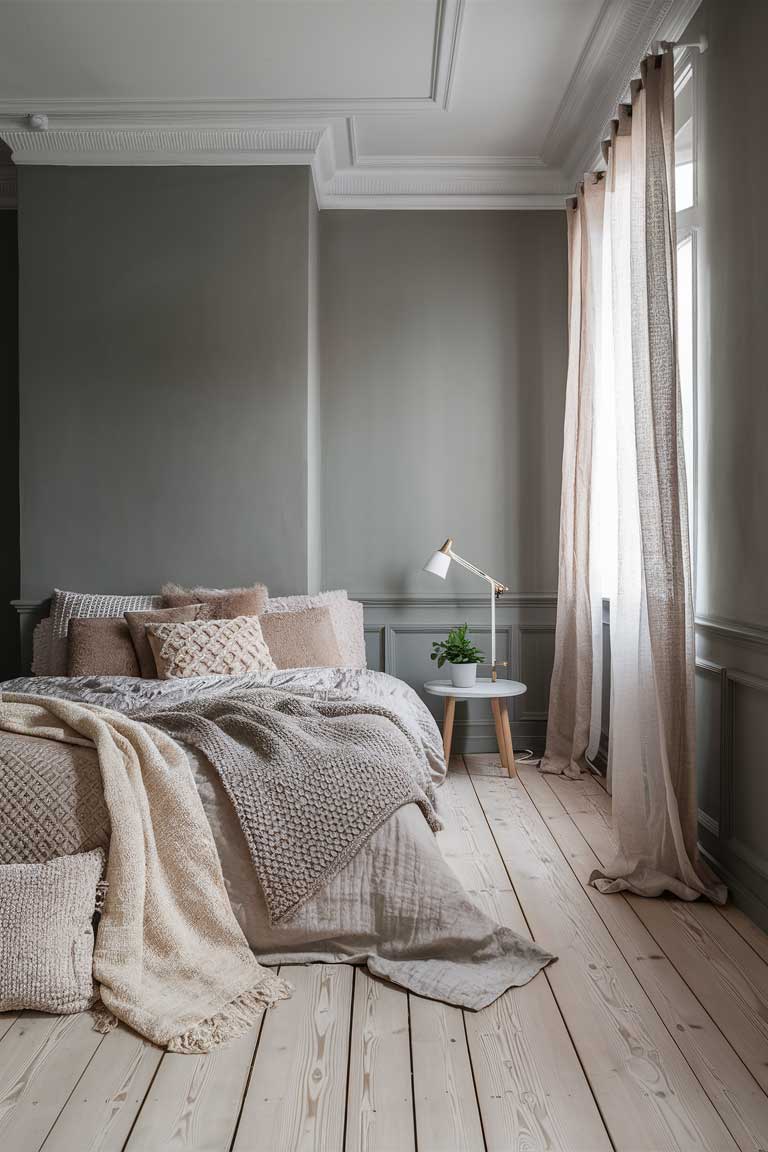
Earthy tones can be introduced through furniture and accessories, adding depth to the neutral base.
Think warm browns, soft greens, and muted terracottas.
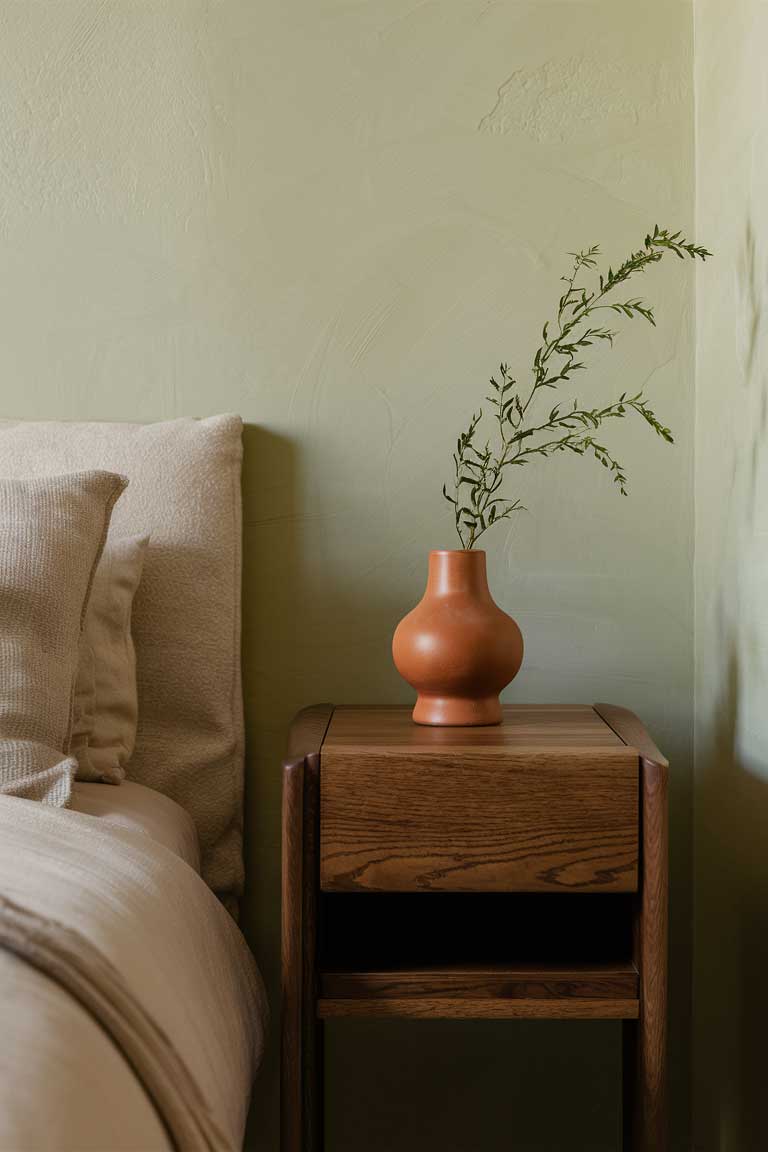
While the overall palette remains neutral, don’t be afraid to introduce subtle accent colors.
A soft blush throw pillow or a pale blue ceramic vase can add enough interest without disrupting the serene atmosphere.
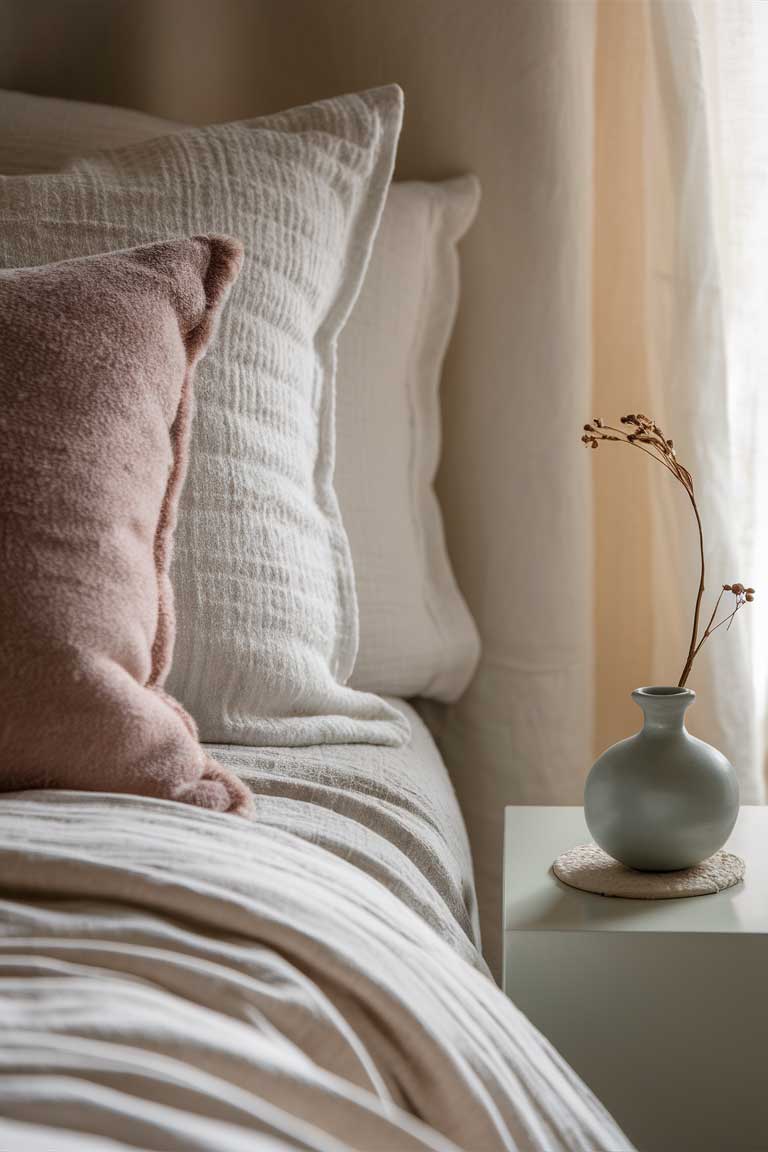
Maximizing Space in Japandi-Style Small Bedrooms
Clever Storage Solutions
Smart storage is essential in a small Japandi bedroom.
Built-in bedside nooks are a fantastic way to save space while providing a spot for nighttime essentials.
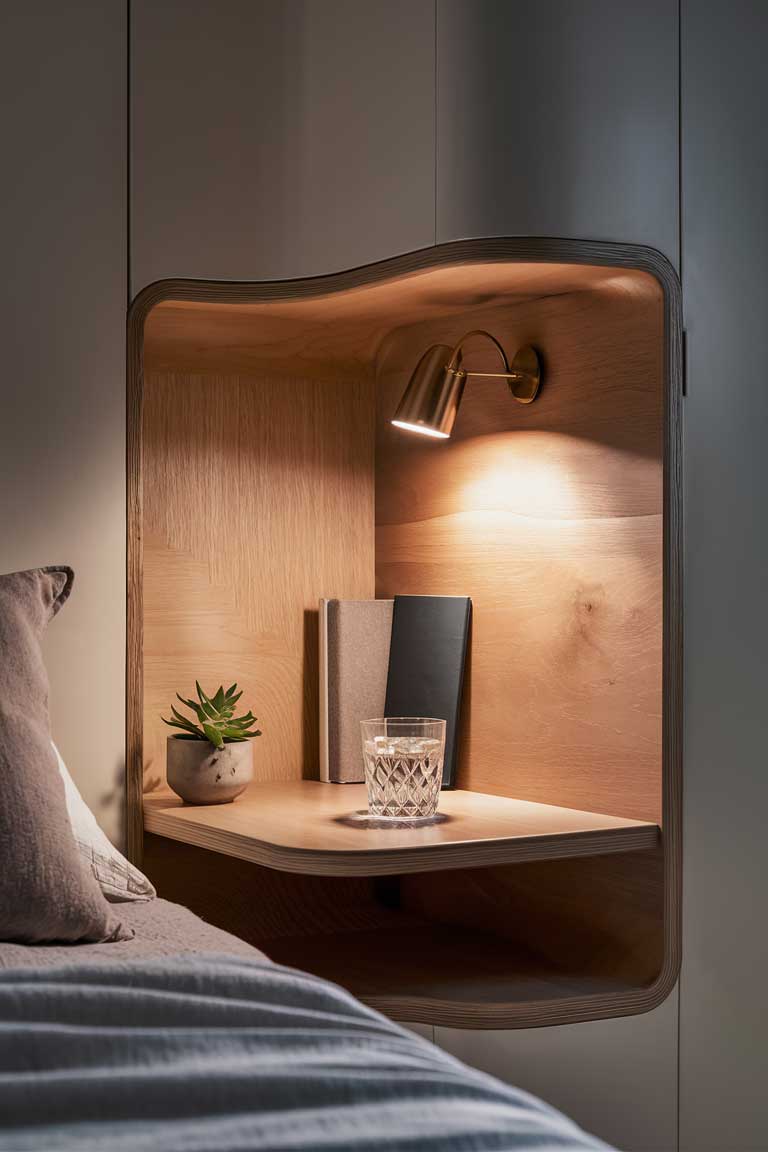
Minimalist wardrobes are another key element.
Look for designs with clean lines and hidden hardware to maintain the uncluttered aesthetic.
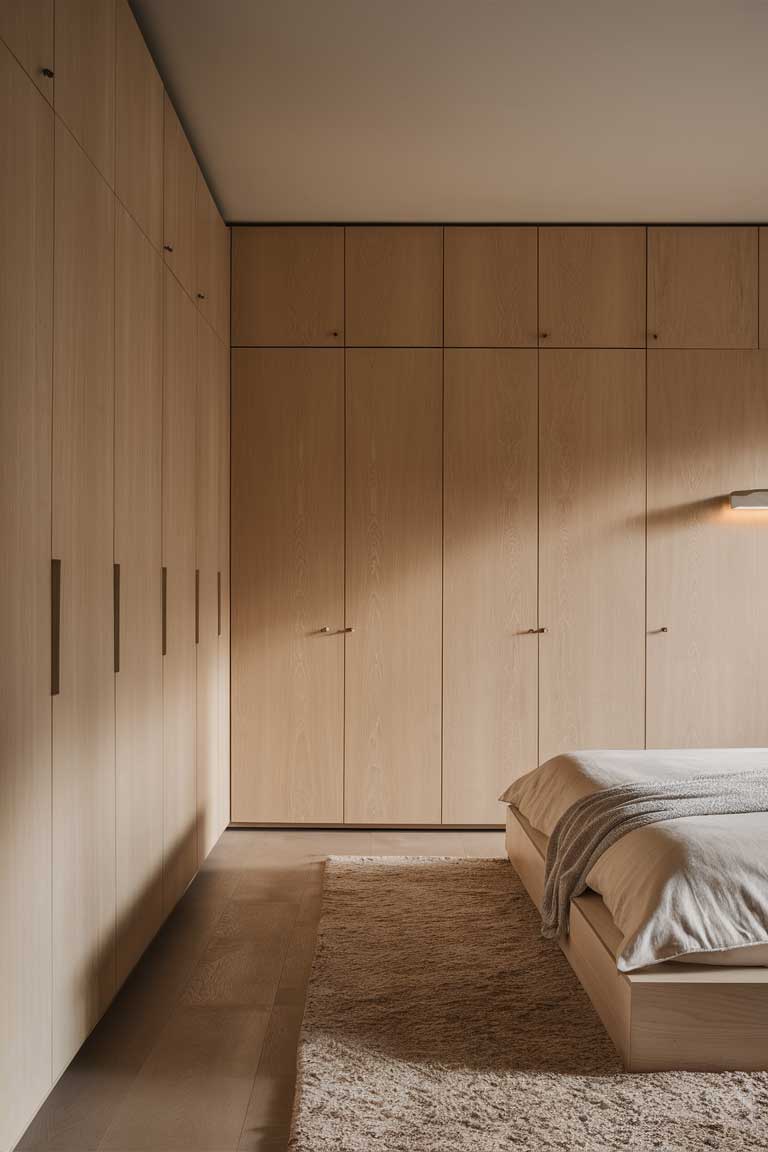
Don’t forget about under-bed storage.
Many platform beds have built-in drawers, offering a discreet place to store extra linens or out-of-season clothes.
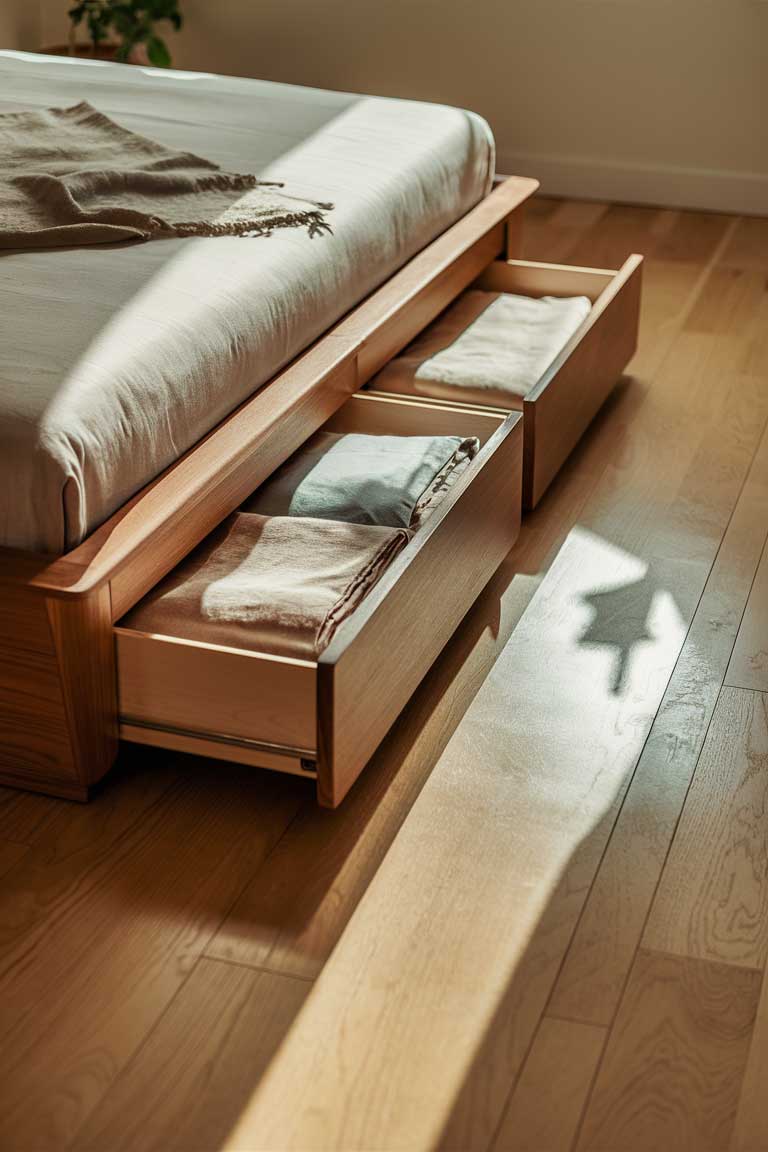
Multi-functional Furniture
Multi-functionality is key in small bedroom design ideas.
A bench at the foot of the bed can serve as both seating and storage.
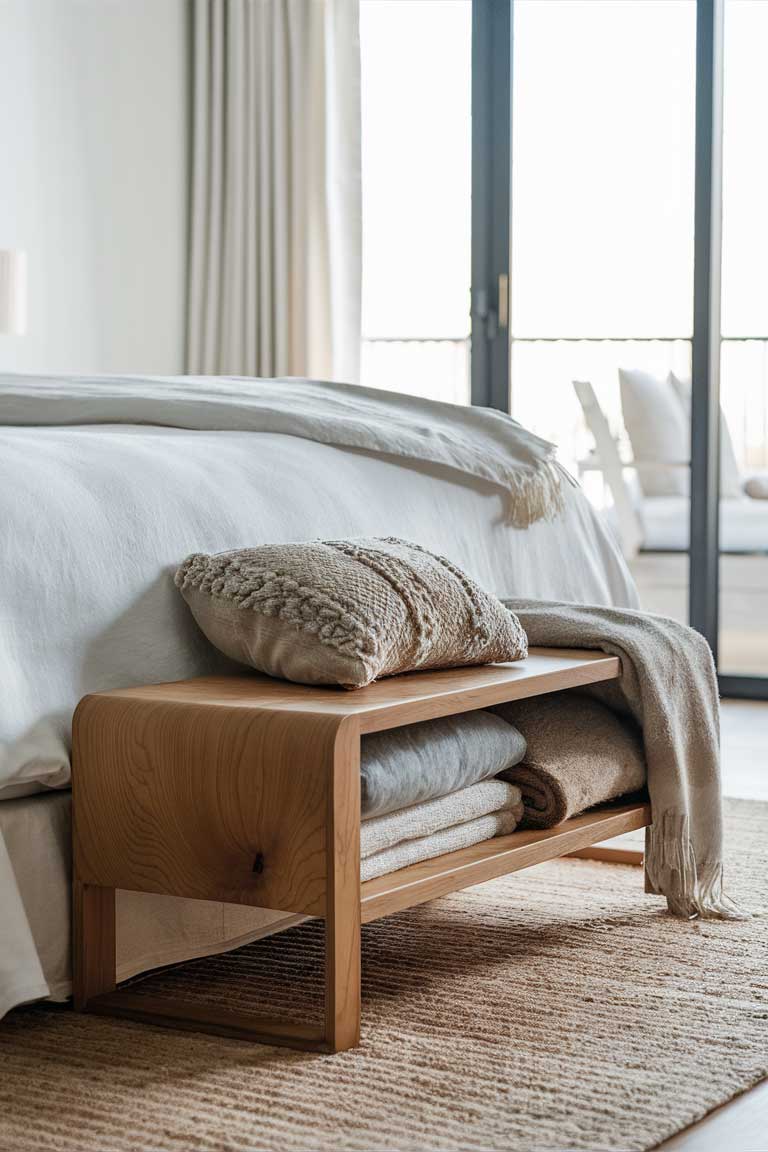
Floor cushions are another versatile addition.
They can be used for seating and then stacked in a corner when not in use.
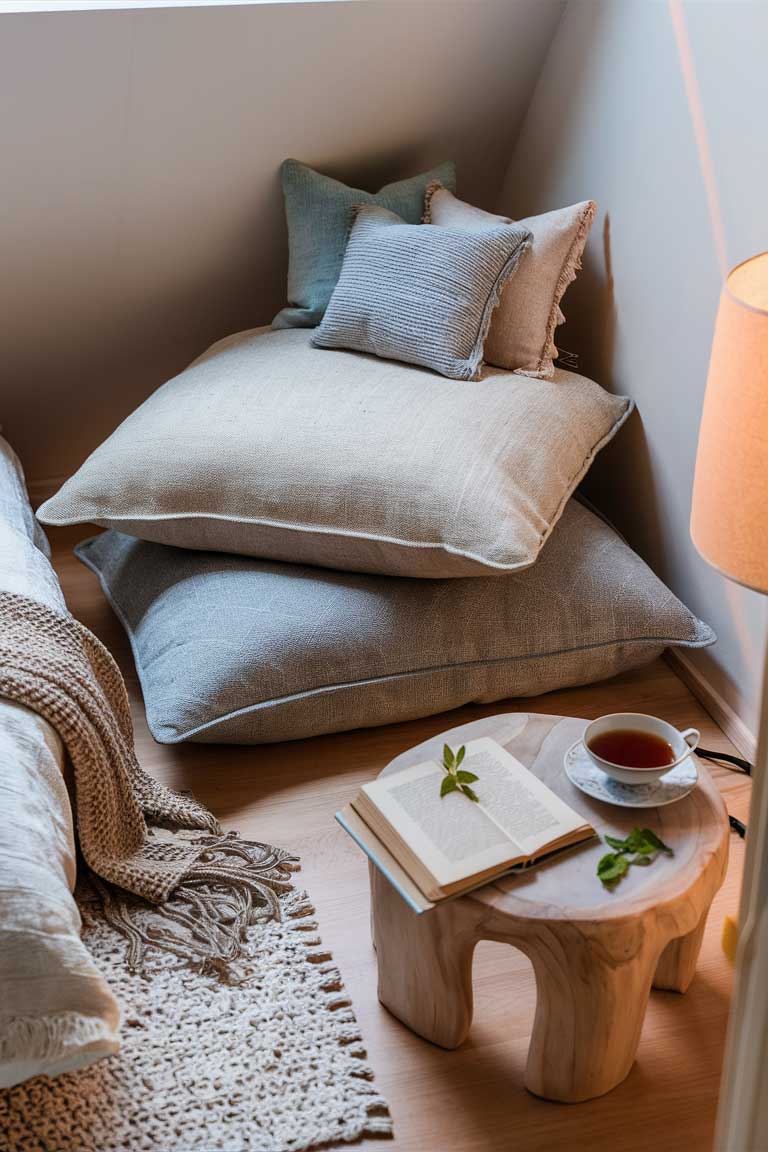
Consider foldable or convertible pieces that can be tucked away when not needed.
A wall-mounted desk that folds down only when you need to work is an excellent example of Japanese minimalism in action.
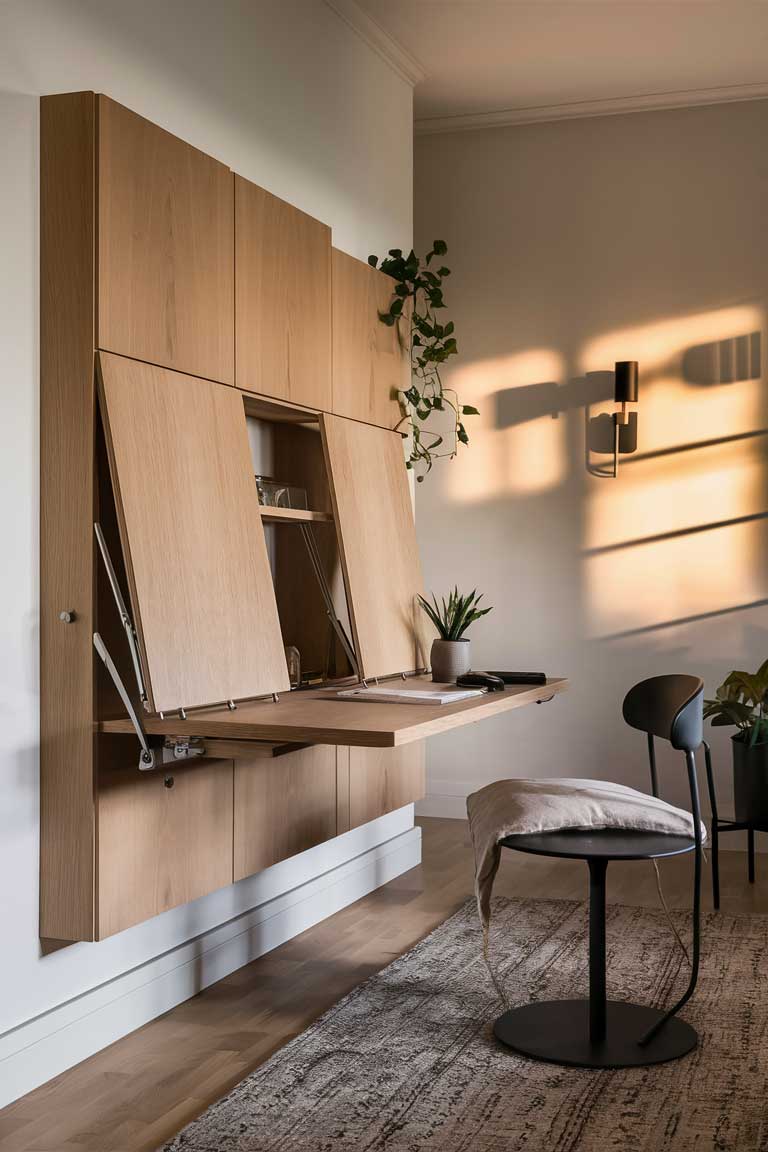
Space-Saving Design Elements
Inspired by traditional shoji screens, sliding paper doors can be a beautiful and practical addition to a small Japandi bedroom.
They take up less space than swing doors and add an authentic touch to the decor.
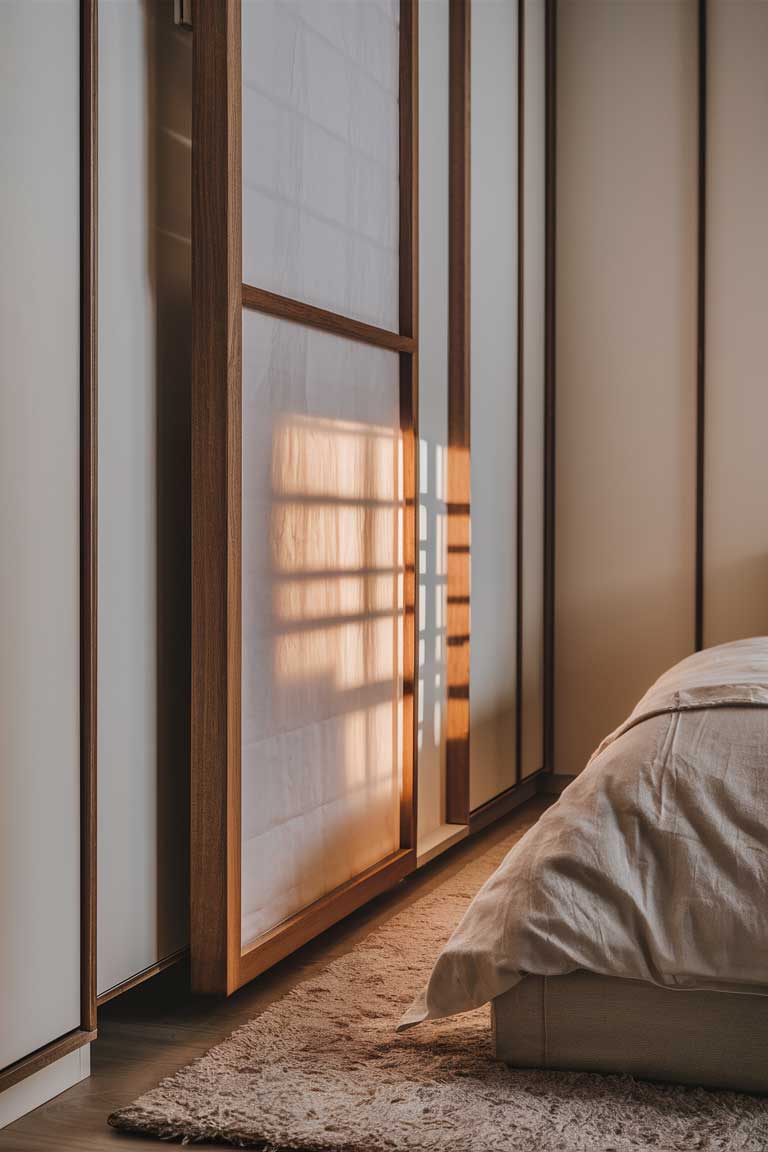
Wall-mounted lighting is another space-saving trick.
Opt for slim, adjustable sconces that provide task lighting without cluttering your bedside tables.
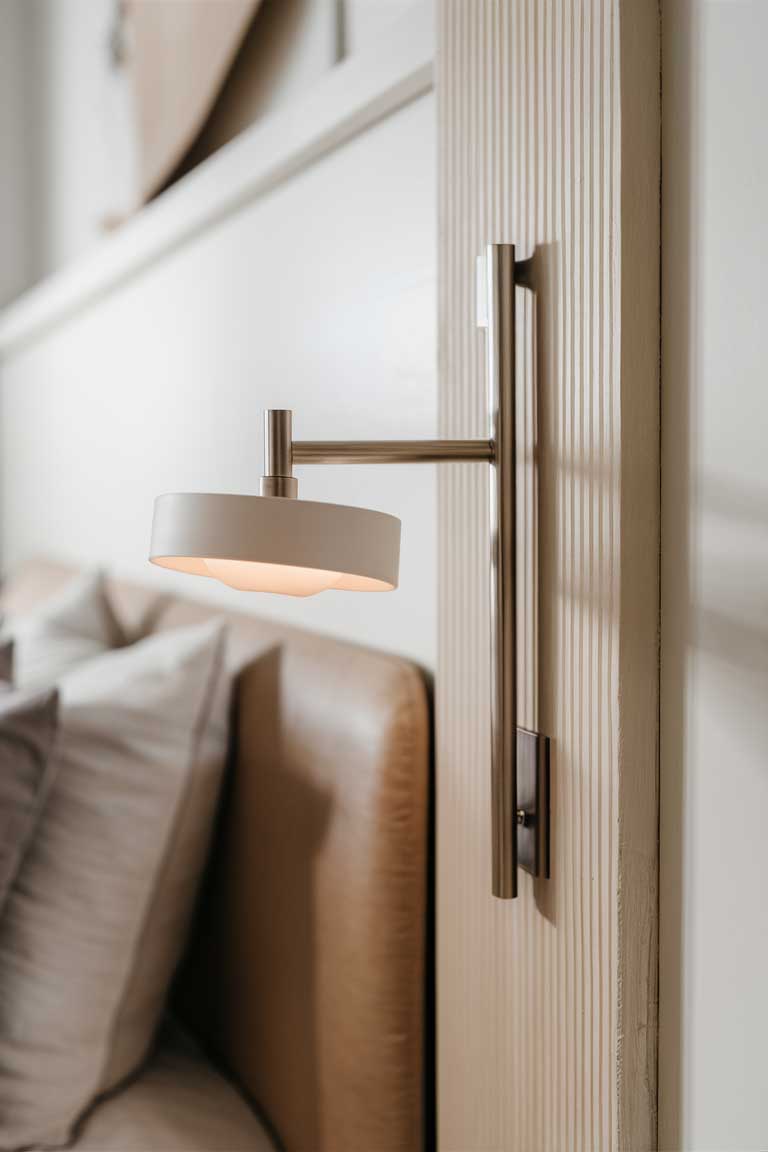
If you need a workspace in your bedroom, consider a compact desk area.
A floating desk with a fold-down top can serve as a vanity and a workstation without taking up valuable floor space.
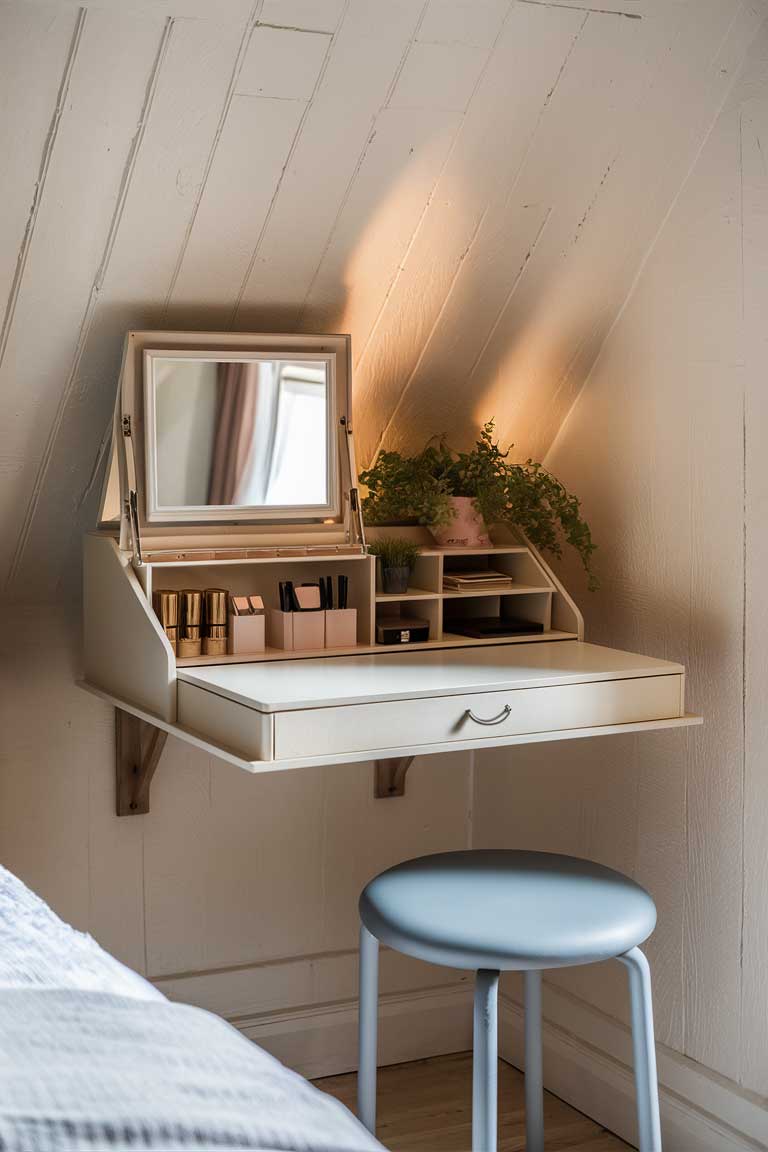
By incorporating these space-saving elements, you can create a small Japandi bedroom that feels open, airy, and incredibly functional.
Remember, in Japandi design, every piece should serve a purpose while contributing to the overall sense of calm and simplicity.
Creating a Serene Atmosphere
Lighting Techniques
Lighting is crucial in setting the mood in a Japandi small bedroom.
Paper lanterns and pendant lights are staples of this style, offering soft, diffused light that creates a calming ambiance.
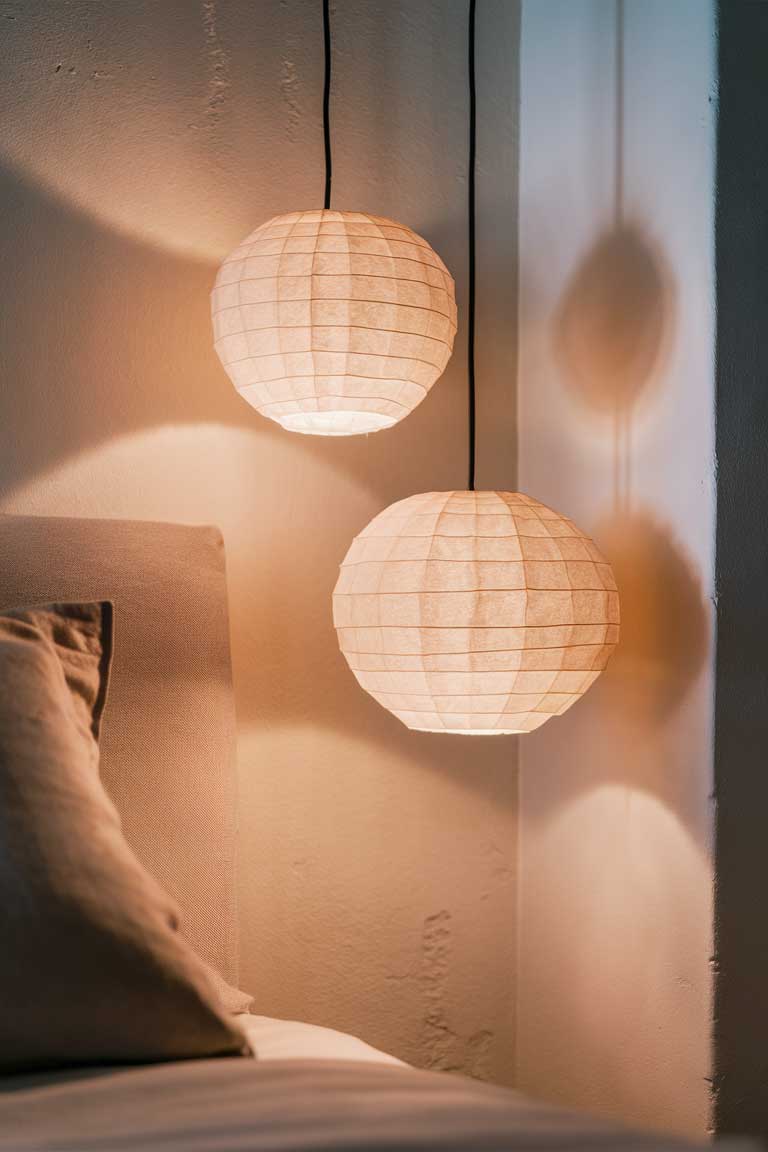
Soft, ambient lighting is key to creating a relaxing atmosphere.
Consider using dimmable LED strips behind headboards or under floating shelves for a subtle, atmospheric glow.
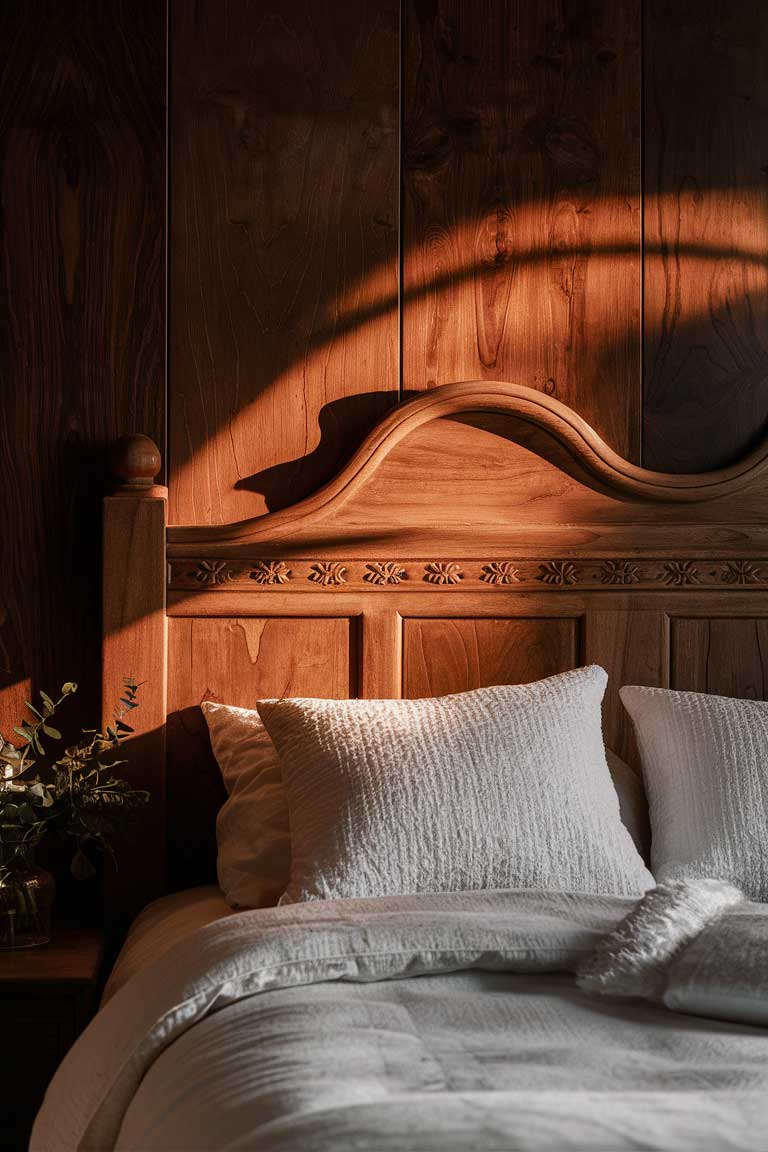
Natural light optimization is also crucial in Japandi design.
Keep window treatments simple and light to allow as much daylight as possible to flood the room.
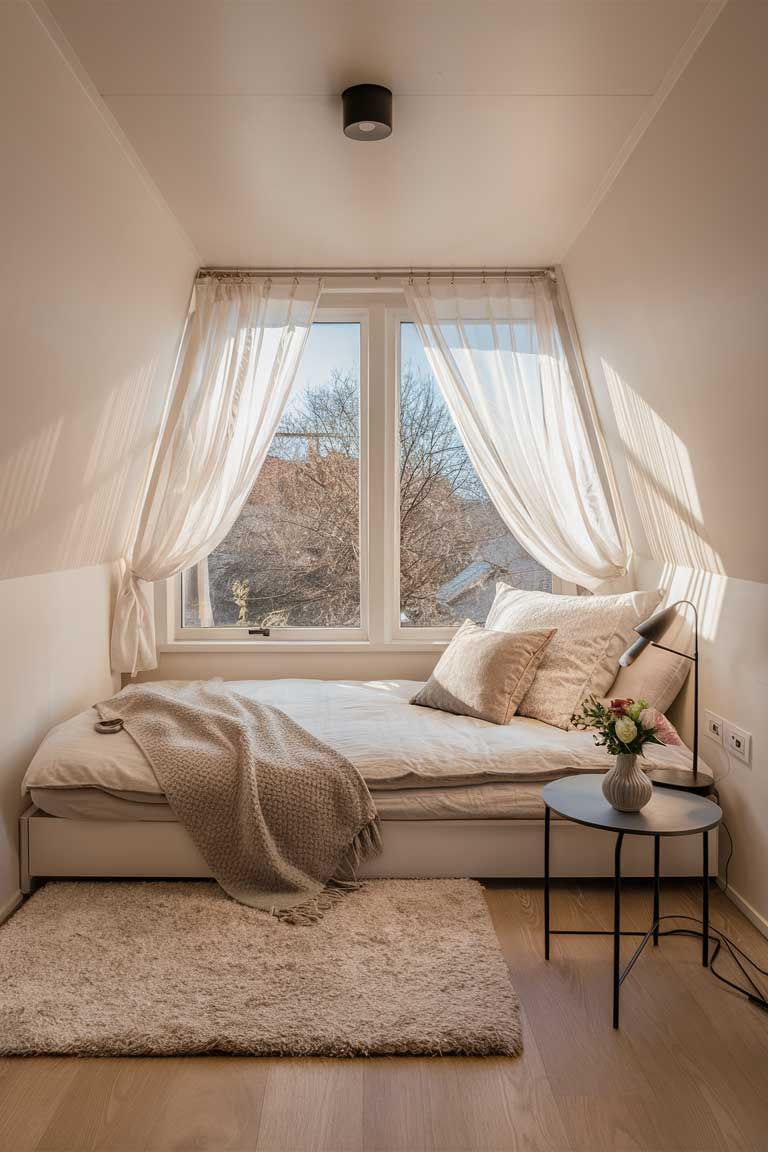
Incorporating Nature
Bringing elements of nature into your bedroom is a fundamental aspect of Japandi design.
Potted plants and bonsai trees are perfect for adding a touch of green to your space.
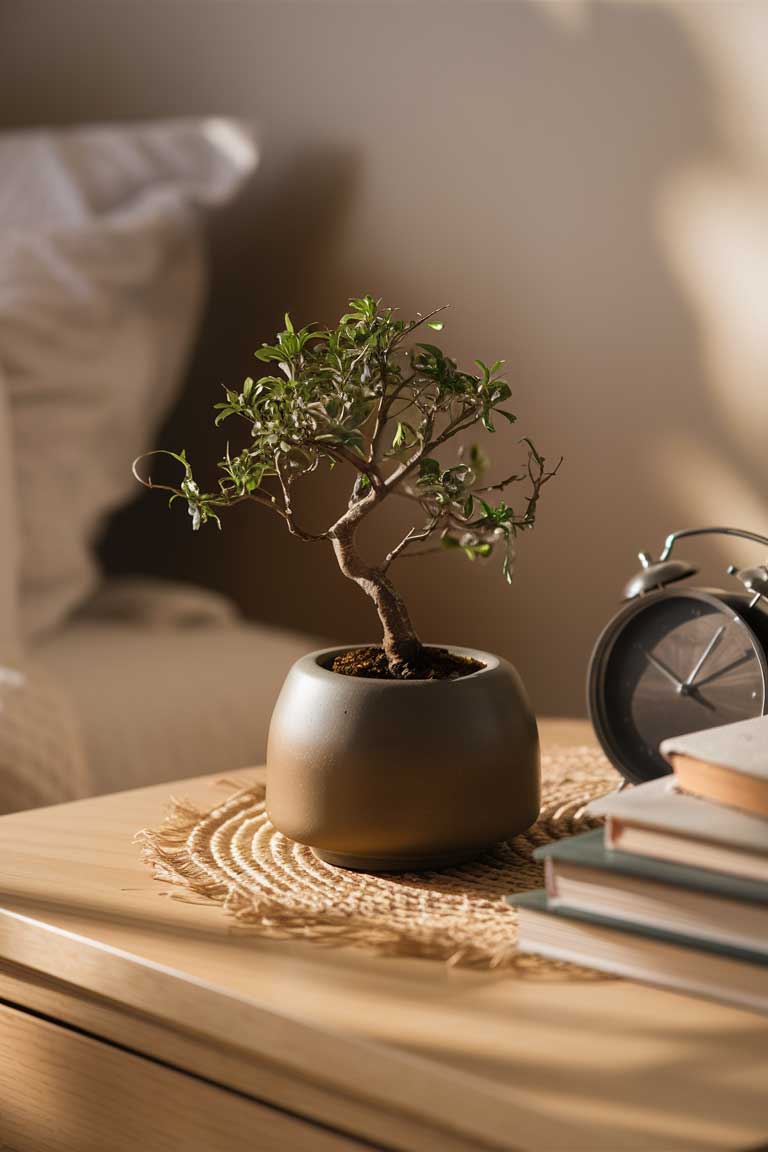
Dried floral arrangements can add texture and interest without requiring maintenance.
They’re also a great way to introduce subtle colors to your neutral palette.
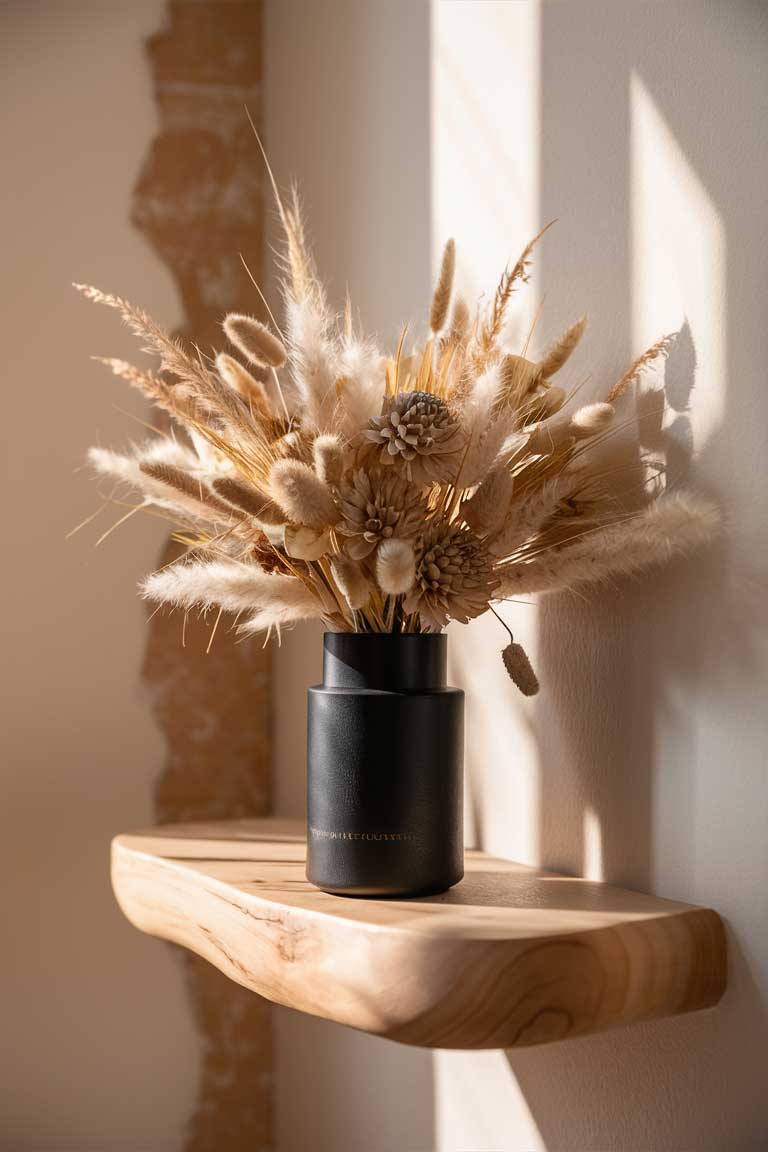
If possible, arrange your bed to have a view of the greenery outside.
This connection to nature is profoundly calming and aligns perfectly with the Japandi philosophy.

Textural Elements
Texture is even more important in a minimal bedroom.
Layered bedding in neutral tones adds depth and interest to the sleeping area.

Woven wall art is a great way to add texture to your walls without introducing too much color or pattern.

Natural fiber rugs underfoot add warmth and comfort to your space.
Look for options in jute, sisal, or wool in neutral tones.
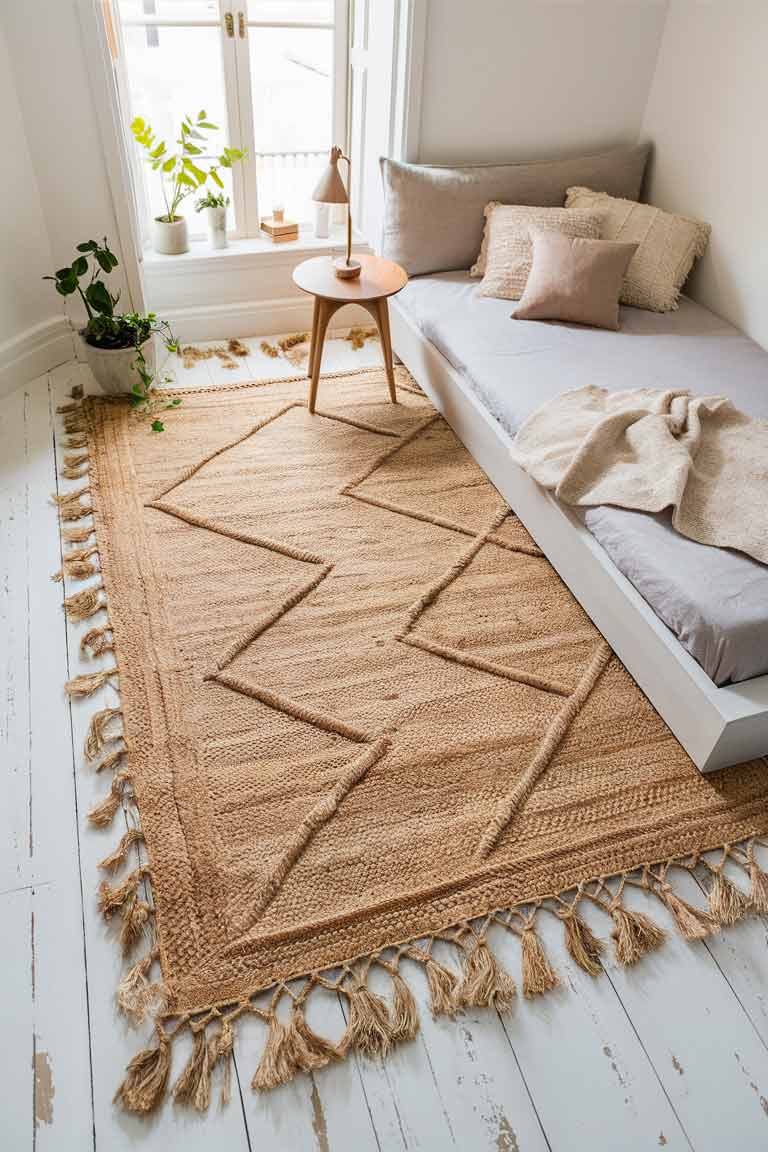
Focusing on lighting, nature, and texture can create a serene atmosphere in your small Japandi bedroom that promotes relaxation and restfulness.
Japandi-Inspired Decor and Accessories
Minimalist Wall Art
When it comes to wall decor in a Japandi small bedroom, less is more.
Black and white prints can add visual interest without overwhelming the space.
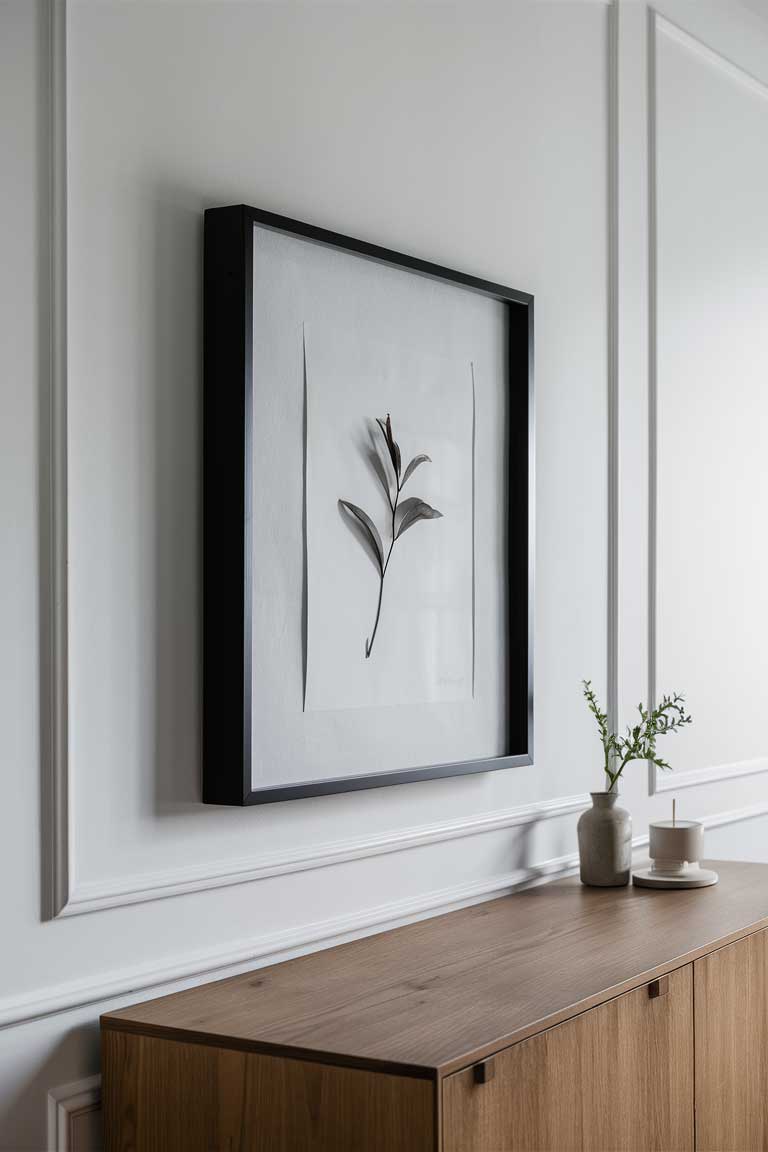
Simple, nature-inspired pieces align perfectly with the Japandi aesthetic.
Think abstract landscapes or botanical sketches.
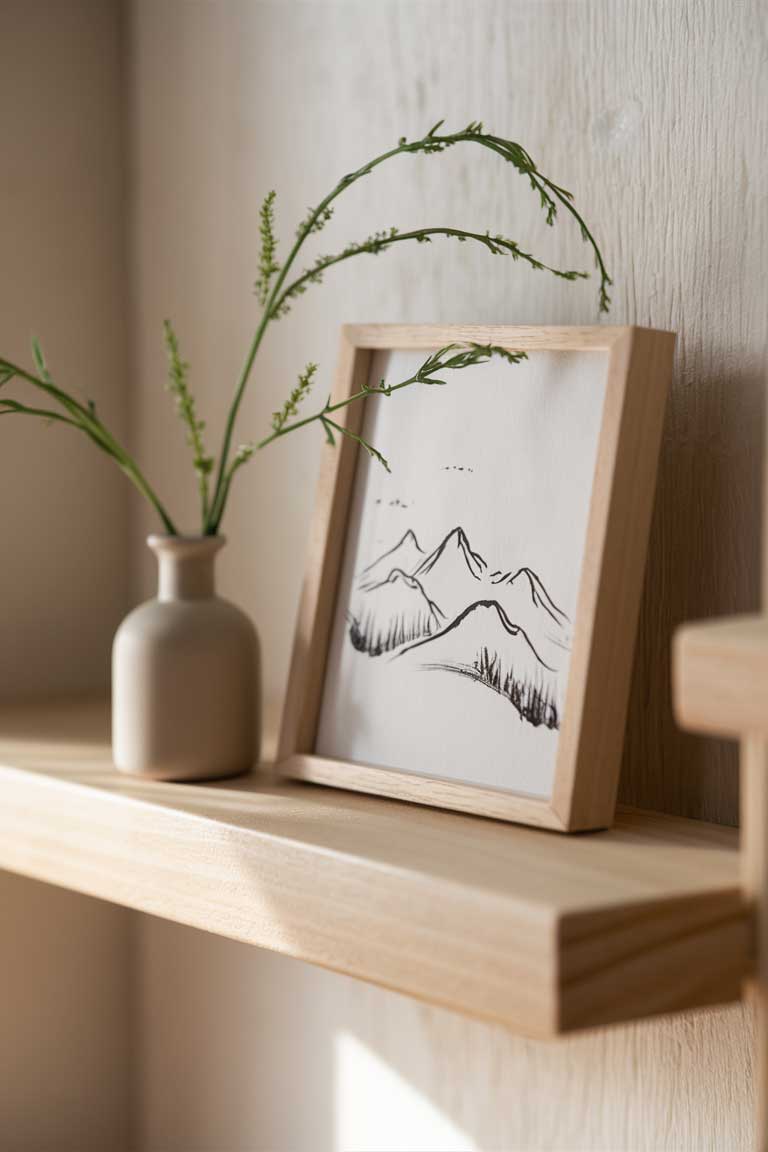
Wabi-sabi elements, which celebrate the beauty of imperfection, can add depth and character to your space.
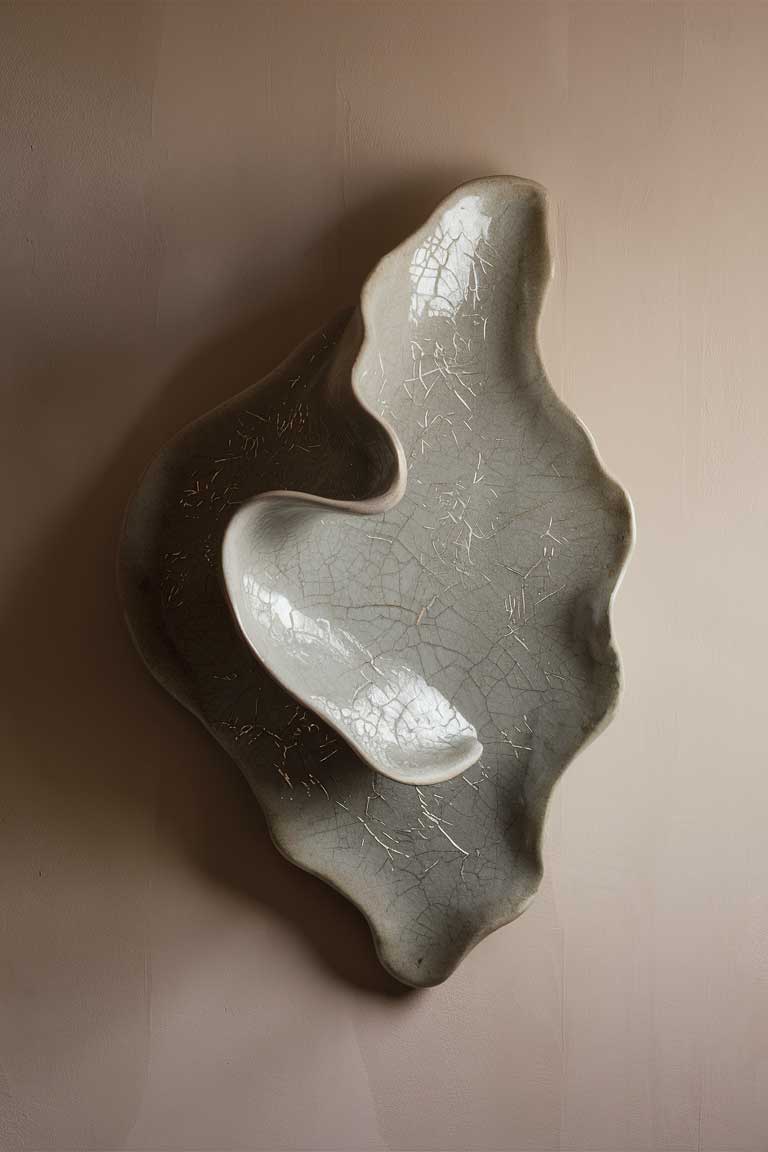
Functional Decor
In Japandi minimalism, every item should serve a purpose.
Ceramic vases with pampas grass or other dried plants can add height and texture to your space while remaining low-maintenance.
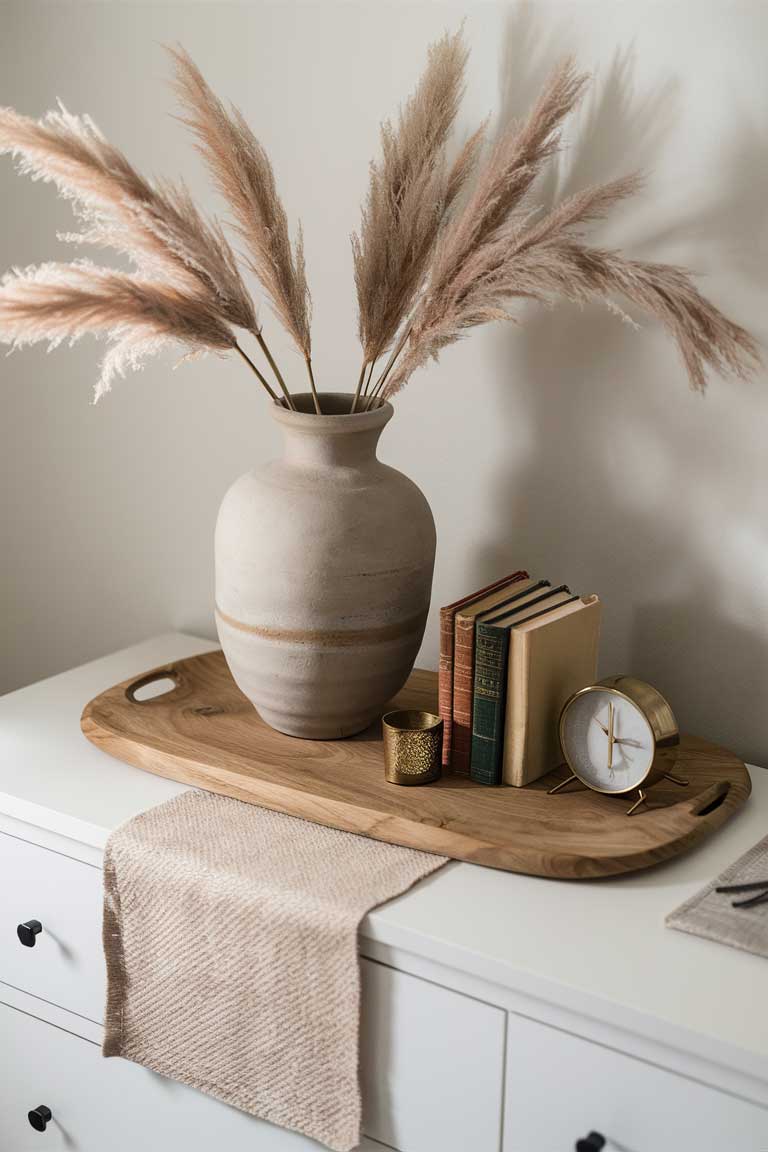
Minimalist clocks can serve as both timepieces and wall art.
Look for designs with clean lines and natural materials.
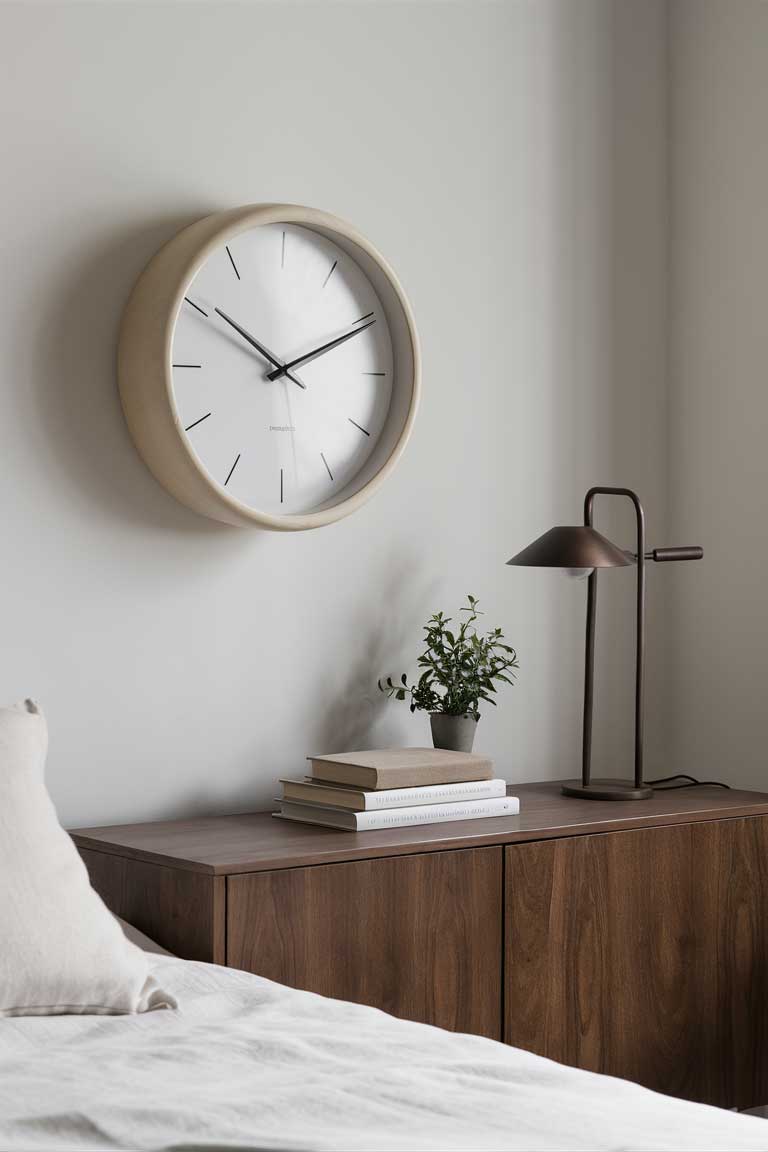
Small sculptures or objects can add personality to your space without creating clutter.
Choose pieces that speak to you and align with the overall aesthetic.
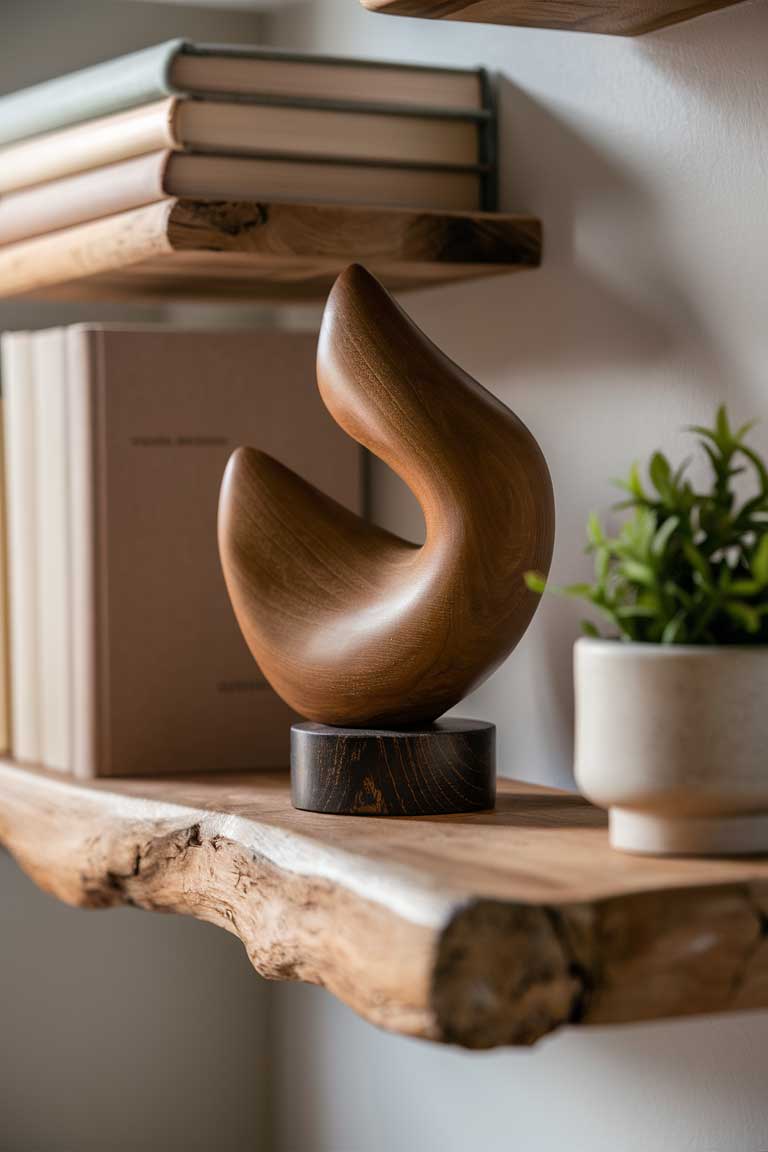
Textile Accents
Textiles are a great way to add warmth and comfort to your Japandi small bedroom.
Shibori-inspired pillows can introduce patterns without overwhelming the space.
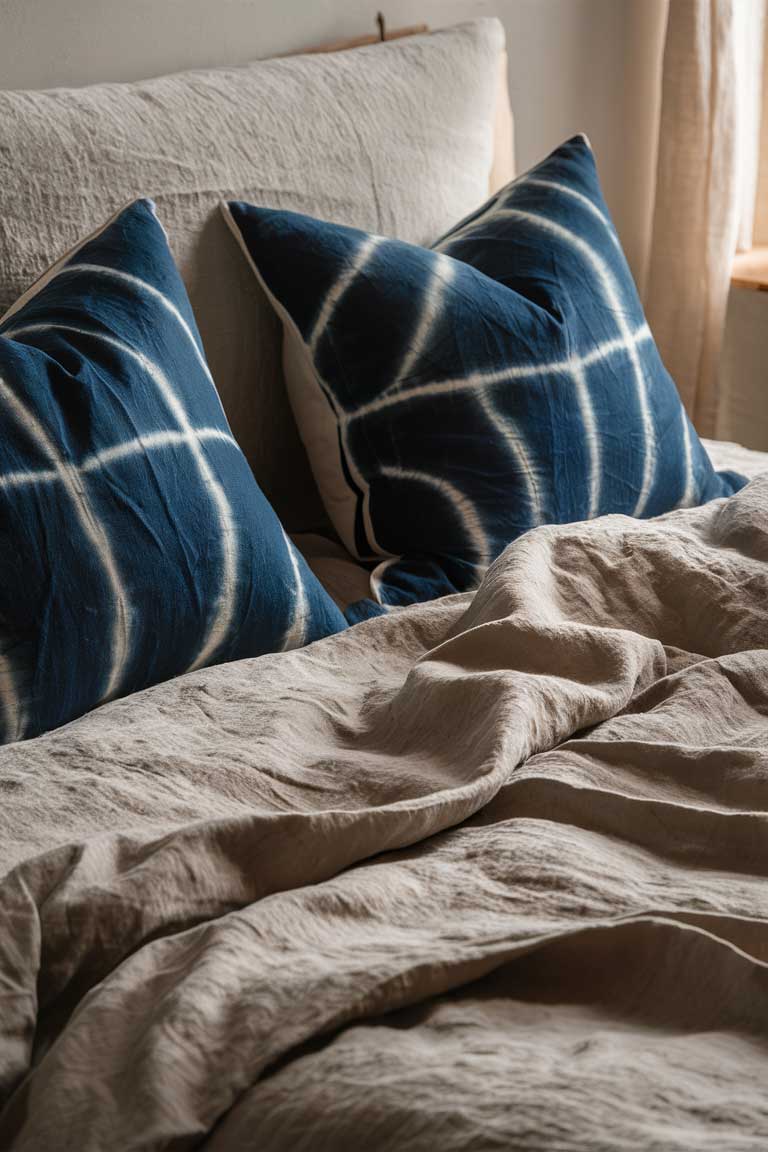
Soft throws in neutral colors can add texture and comfort to your bed or reading nook.
Look for natural fibers like wool or cotton in muted tones.

Bamboo or linen window treatments can provide privacy while allowing natural light to filter through.
They also add a natural, organic element to your space.

Practical Japandi Bedroom Layouts for Small Spaces
Utilizing Corners
In small bedroom design ideas, using every inch of space is crucial.
Creating a reading nook with floor cushions in a corner can add functionality without sacrificing too much floor space.
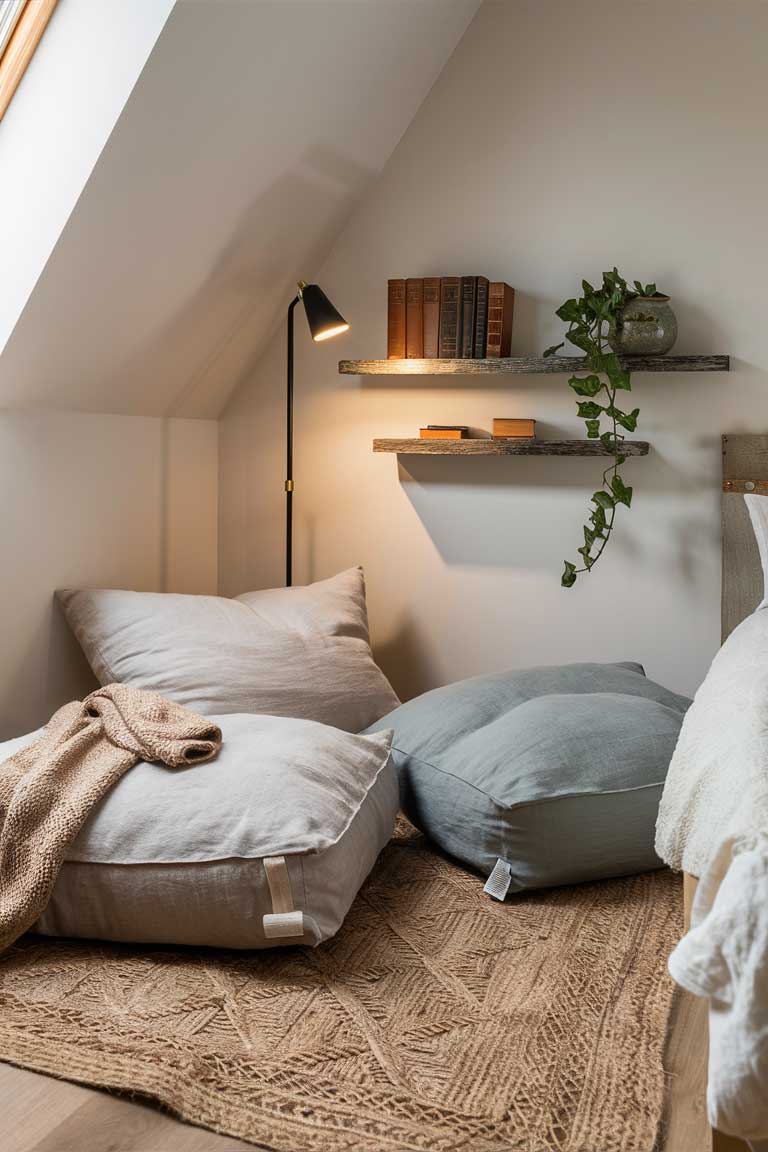
Compact workspace setups can be integrated into a corner of your bedroom if needed.
Look for slim desks or wall-mounted options to minimize their footprint.
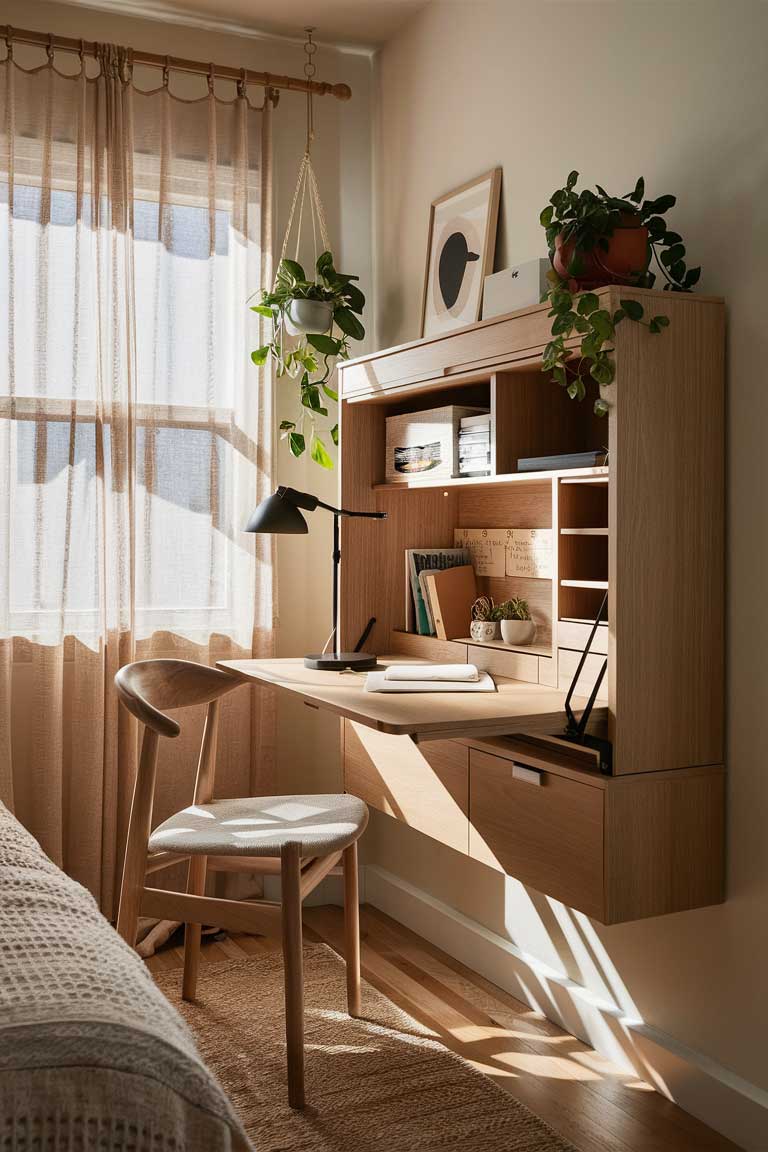
Vertical storage solutions can help you make the most of corner spaces.
Consider tall, narrow shelving units or hanging organizers.
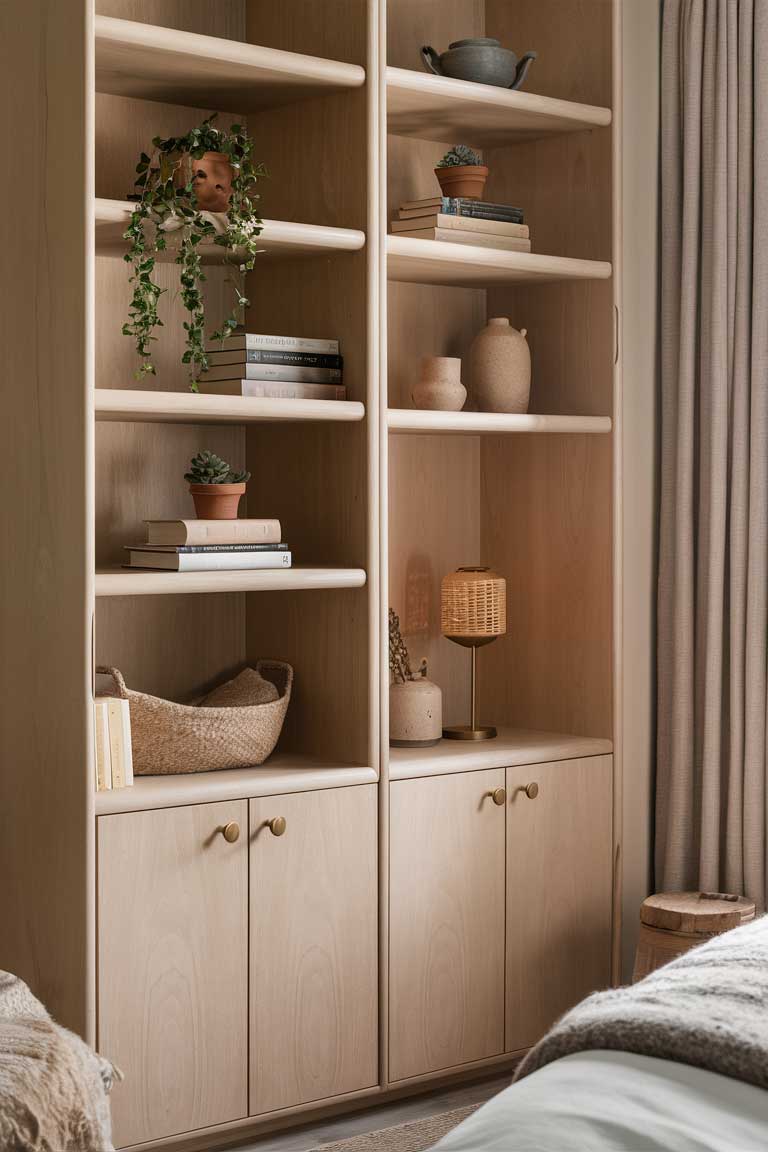
Bed Placement Strategies
In a small Japandi bedroom, the placement of your bed can significantly impact the feel of the space.
Placing the bed against the wall can free up valuable floor space.
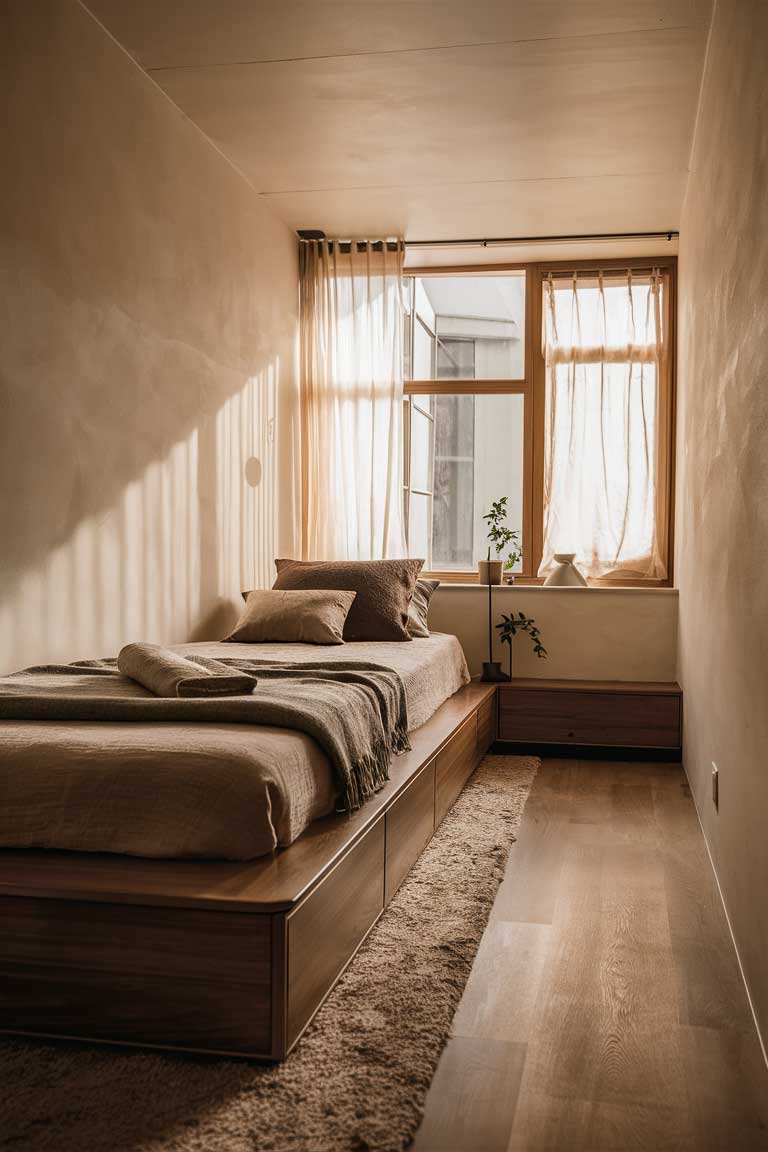
Positioning the bed under a window can create a beautiful focal point and allow you to wake up to natural light.
Just be sure to use appropriate window treatments for privacy.
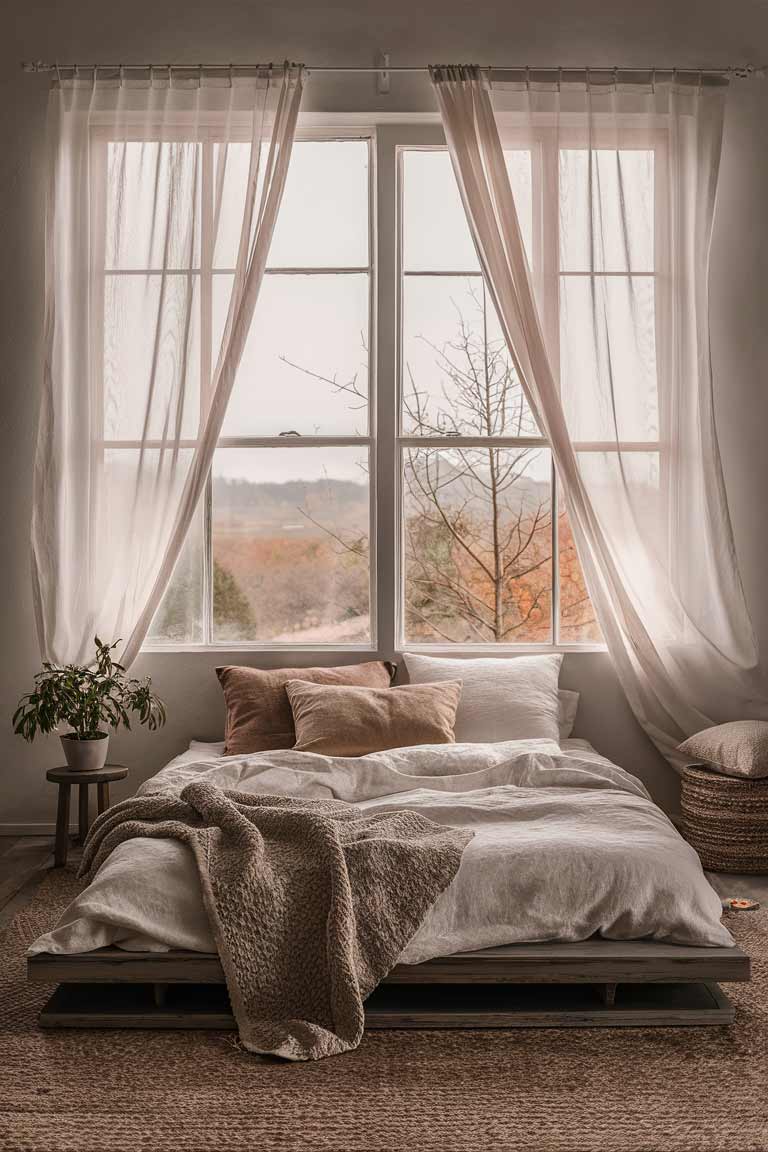
Creating a built-in alcove for your bed in some small spaces can maximize floor space while adding a cozy, nestlike feel.
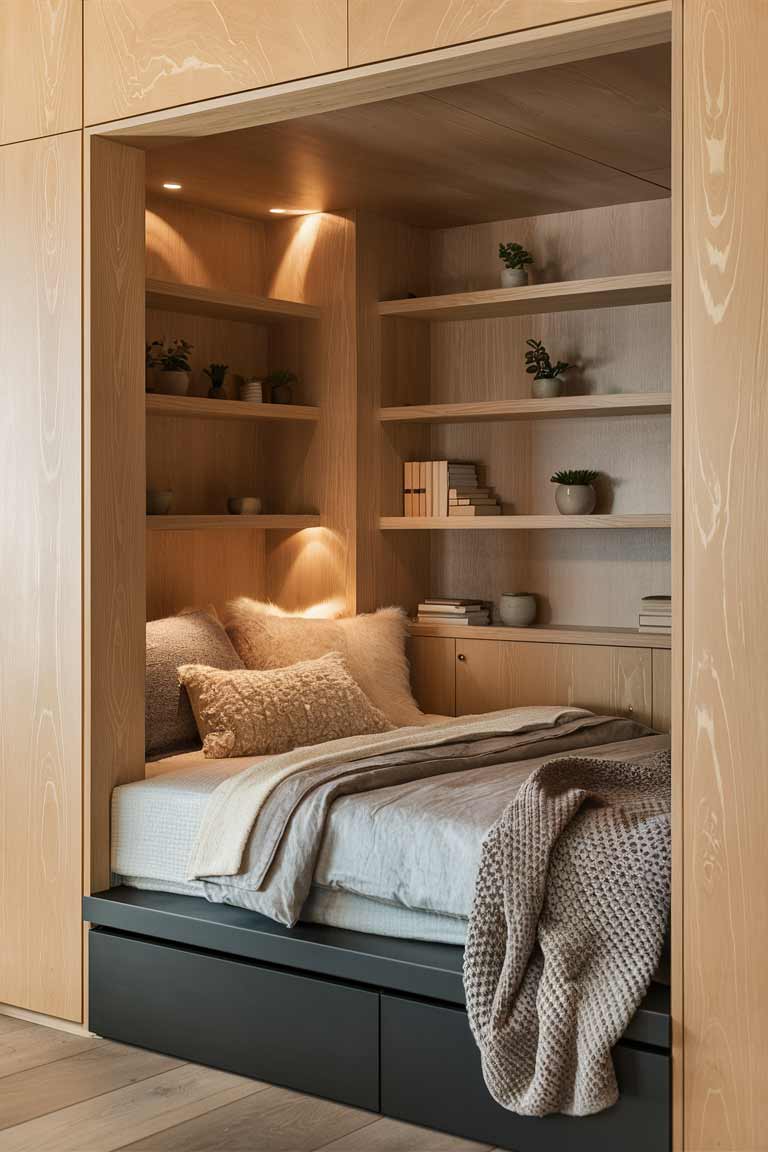
Creating Visual Space
Using mirrors strategically can help create the illusion of more space in your small Japandi bedroom.
A large mirror opposite a window can reflect light and views, making the room feel larger.
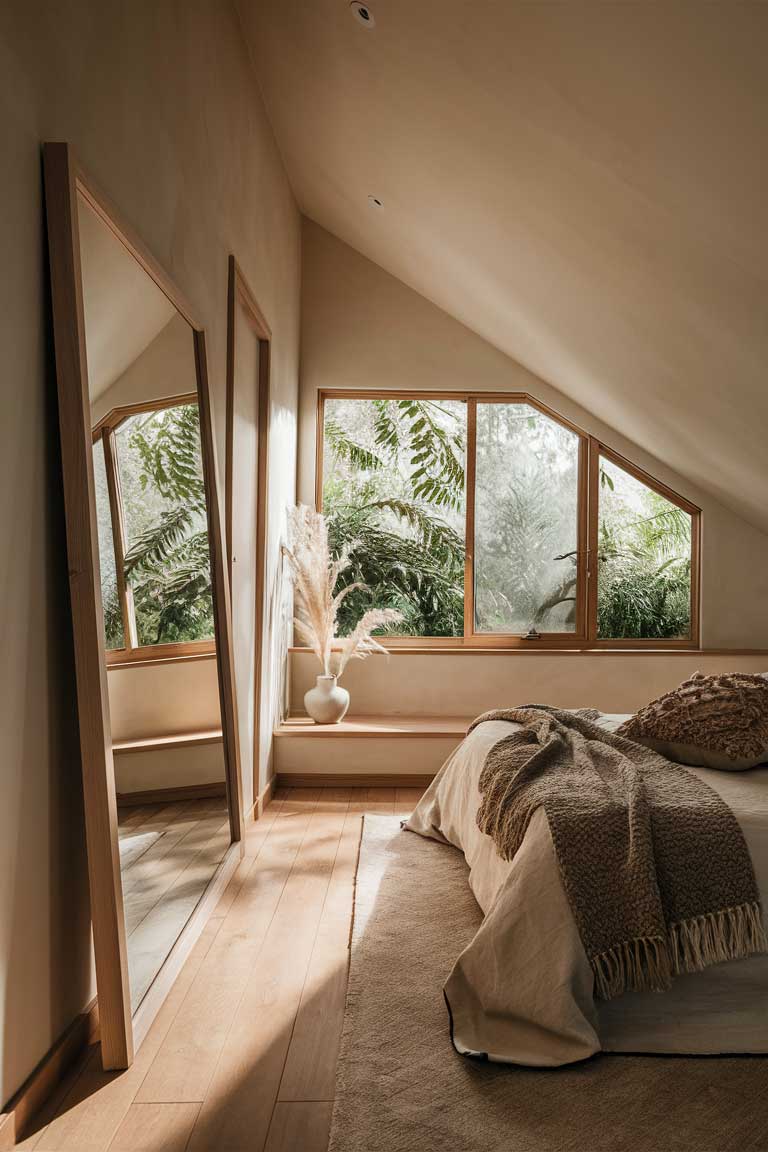
Implementing clear pathways around your furniture is crucial for maintaining a sense of openness.
Avoid cluttering walkways with furniture or accessories.
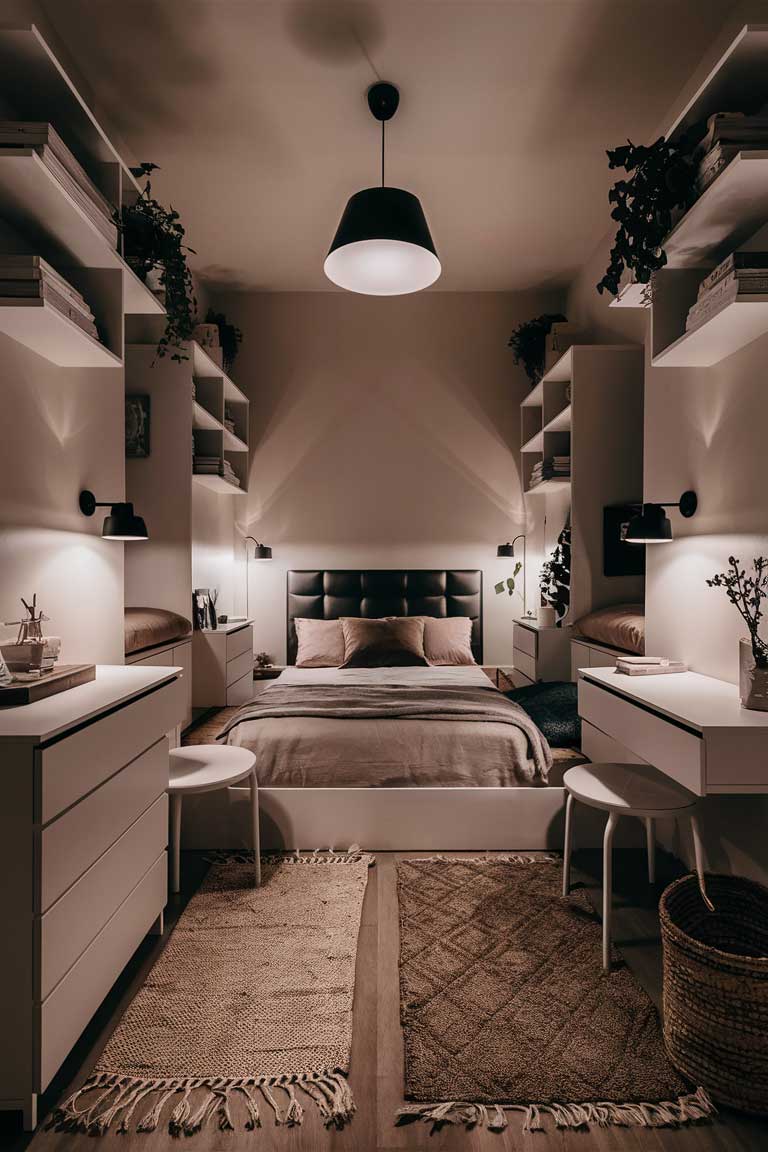
Maintaining clutter-free surfaces is key to the Japandi aesthetic and helps small spaces feel more open.
Use hidden storage solutions to keep surfaces clear.
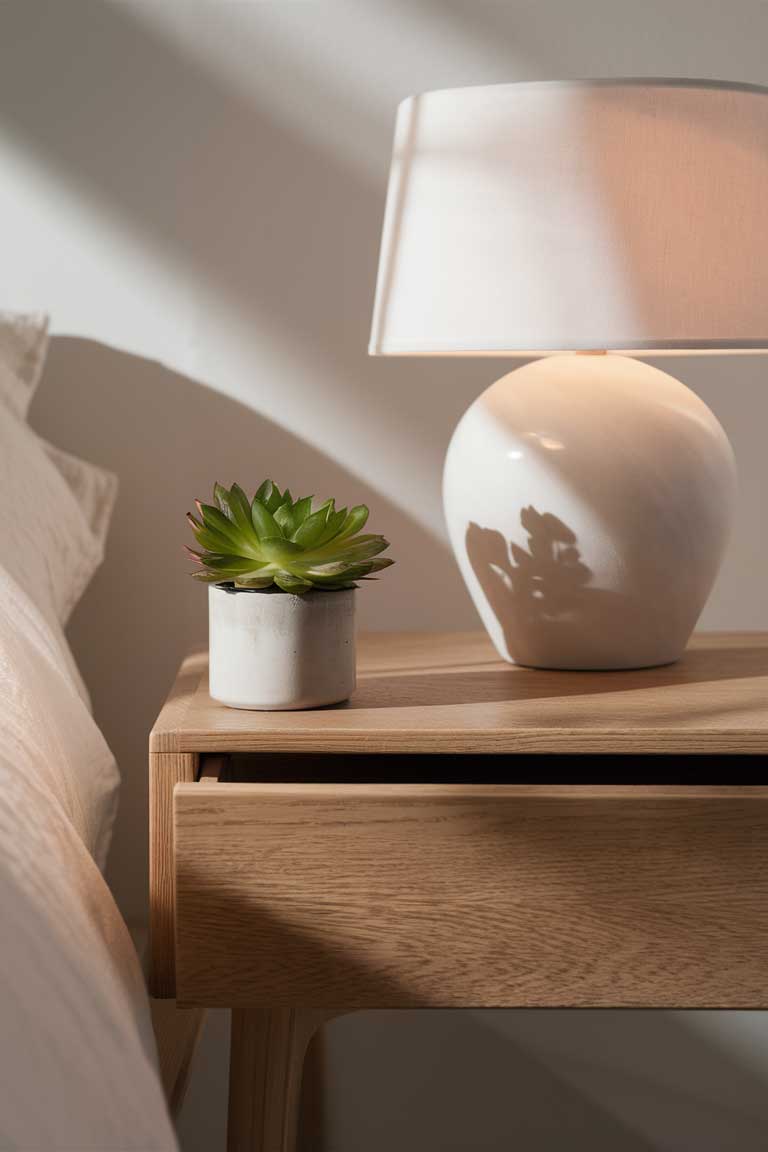
Balancing Functionality and Aesthetics
Smart Technology Integration
In a minimal Japandi bedroom, technology should be present but unobtrusive.
Hidden charging stations can keep your devices powered without adding visual clutter.

Minimalist sound systems can add functionality without disrupting your decor.
Look for sleek, wireless options that can be easily tucked away.

Smart lighting controls can help create the perfect ambiance in your Japandi small bedroom.
Consider installing dimmable LED strips or smart bulbs that can be controlled from your phone.
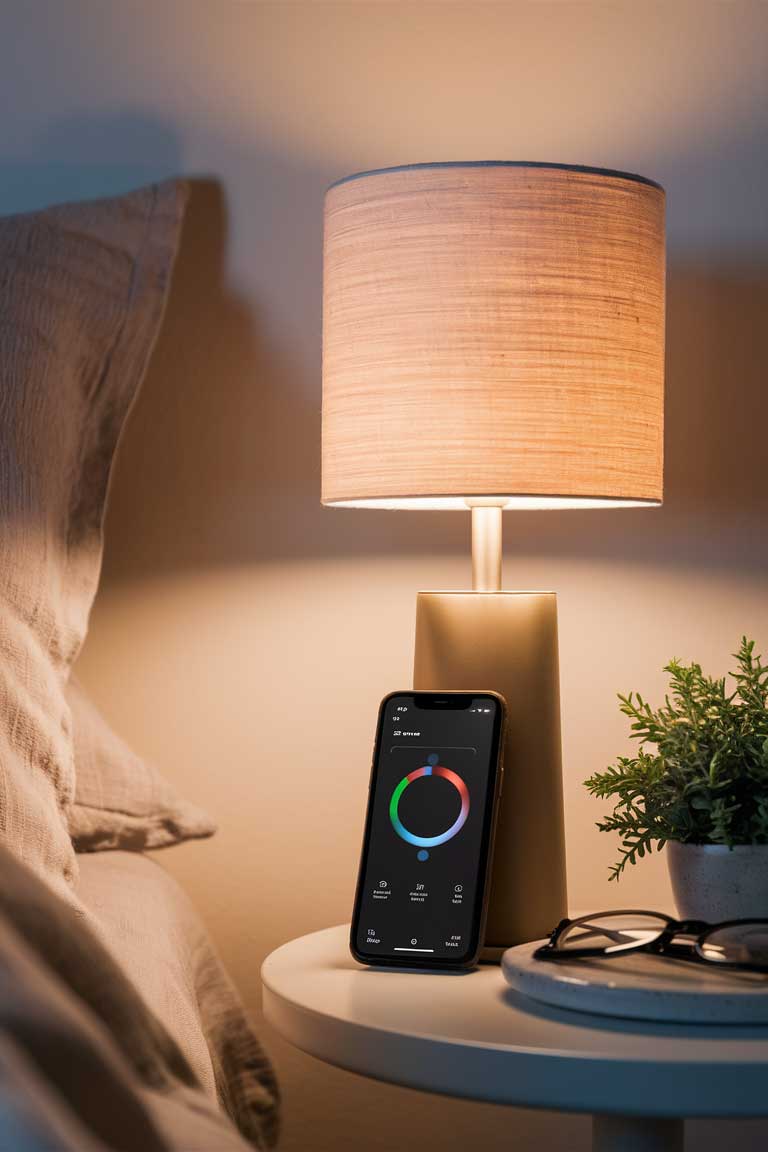
Personalization Within Constraints
While Japandi design emphasizes minimalism, injecting your personality into the space is essential.
A curated display of personal items can add character without creating clutter.
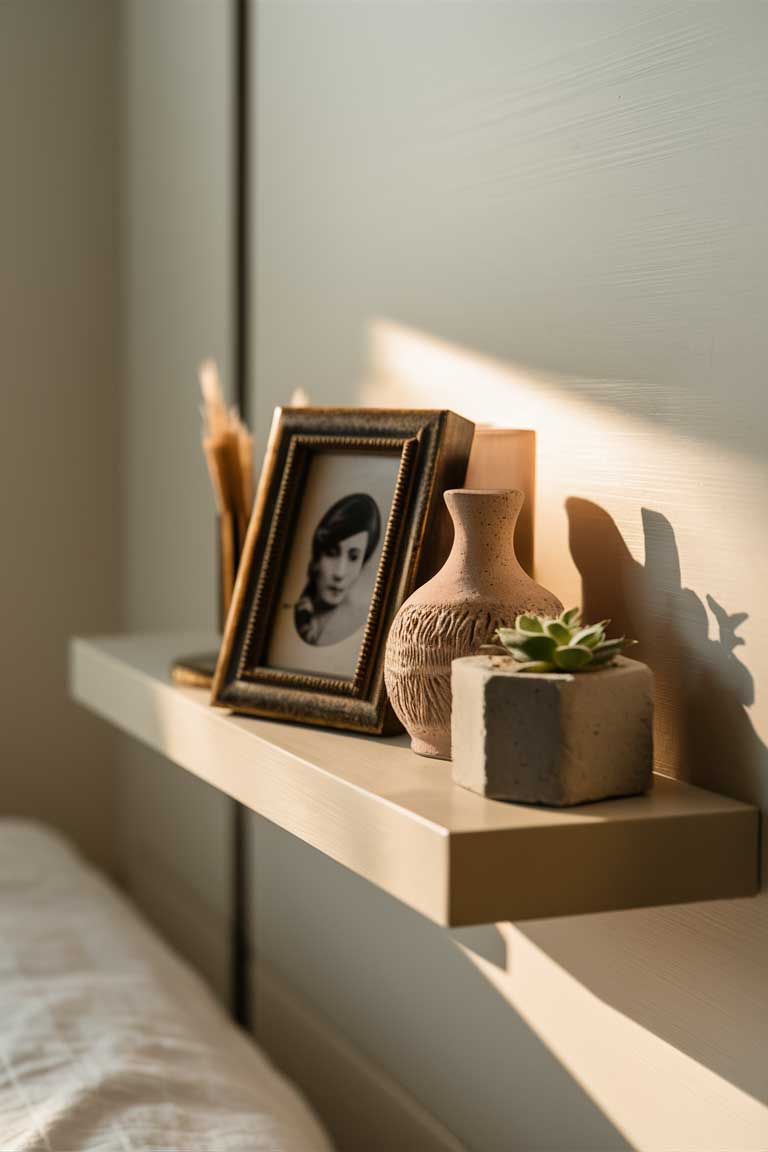
Rotating seasonal decor can keep your space fresh without accumulating too many items.
Consider swapping out throw pillows or artwork seasonally.
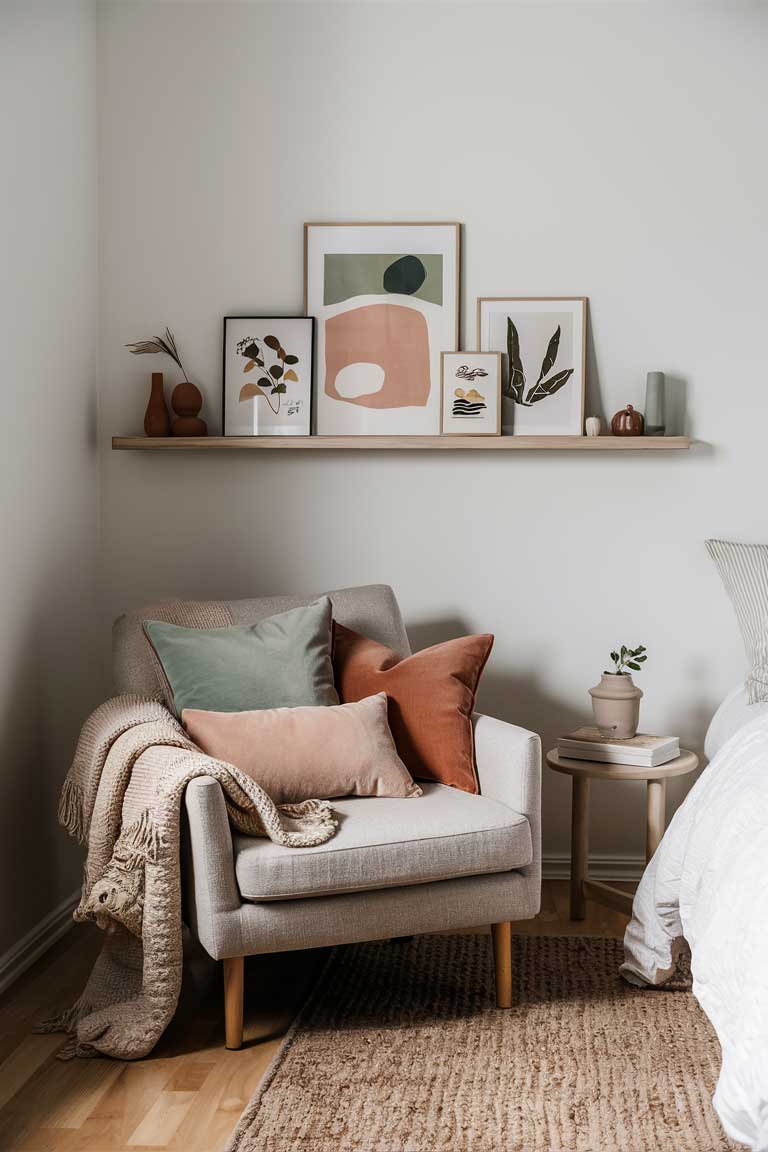
Customizable bedding arrangements allow you to adjust your space for different seasons or moods.
Layering neutral linens with various textures can create interest without departing from the Japandi aesthetic.
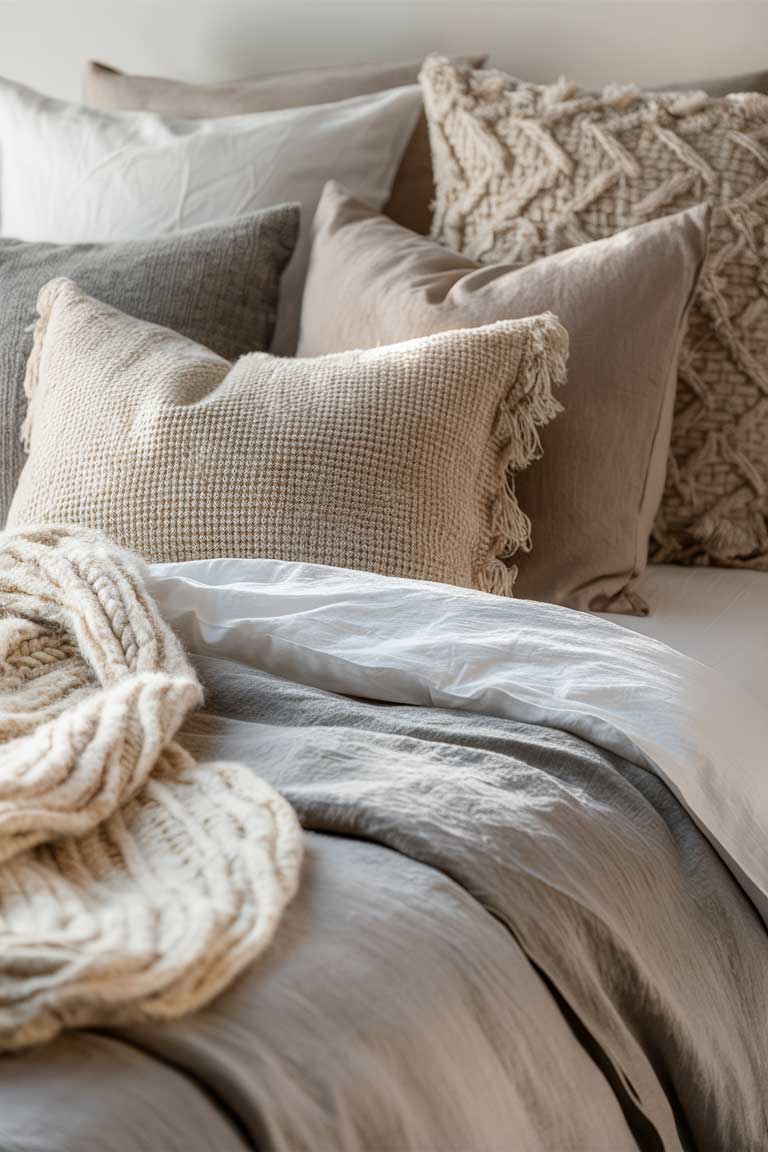
Conclusion
Creating a Japandi small bedroom is about finding the perfect balance between functionality and aesthetics.
By embracing minimalist furniture, natural materials, and a neutral color palette, you can transform even the tiniest bedroom into a serene retreat.
Remember, the key to successful small bedroom designs is maximizing every inch of space while maintaining a clutter-free environment.
Clever storage solutions, multi-functional furniture, and space-saving design elements are your best friends in this endeavor.
Remember to infuse your personality into the space.
While Japandi design emphasizes simplicity, it doesn’t mean your room should feel sterile or impersonal.
Carefully chosen decor, personal items, and textiles can add warmth and character to your space without compromising its serene atmosphere.
Ultimately, your Japandi small bedroom should reflect your personal style and needs.
It should be a space that calms you, inspires you, and provides a perfect backdrop for rest and rejuvenation.
By applying these Japandi bedroom ideas for small rooms, you can create a space that’s beautiful and perfectly tailored to your lifestyle.
So, embrace the art of Japanese minimalism, blend it with Scandinavian coziness, and transform your small bedroom into a Japanese haven.
After all, good things do come in small packages!

